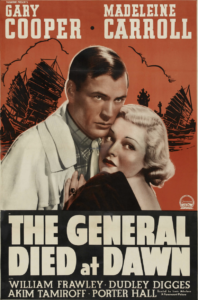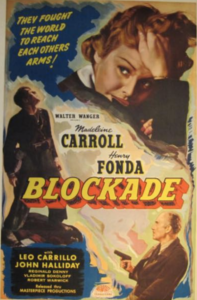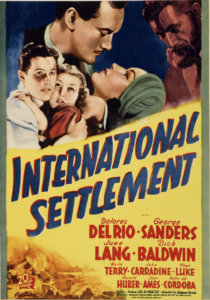Spy Noirs & the Origins of Film Noir in the UK & US

The Unrecognized History in Film Noir
In Five Graves to Cairo, Corporal John J. Bramble (Franchot Tone), like many men and women in an espionage story, becomes an imposter. He is a survivor of the British Eighth Army in North Africa, which was, according to the film’s introduction, “beaten, scattered, and in flight” in June 1942. He makes it across the desert to an isolated hotel, “The Empress of Britain.” Despite its bold name, its ramshackle condition implies that the UK is not the imperial great-power it once was.
A short time later, the German Afrika Korps arrive, and the hotel is commandeered by Field Marshal Erwin Rommel (Erich von Stroheim). Bramble pretends to be the hotel’s French waiter, Paul Davos, who was killed when the Nazis bombed the area the night before. Bramble later discovers that the real Davos also had a secret life – he was a German agent. Taking advantage of this knowledge, Bramble deceives Rommel and gains his confidence.
The Desert Fox shows Bramble a map of Egypt. He says the British officers that he has captured wouldn’t be able to figure out where the Germans had “dug supplementary supplies into the sands of Egypt,” even if they were to see the map. Because Rommel thinks Bramble isn’t British, he assumes the waiter can simply look at it and spot “the five graves to Cairo,” the locations with buried “petrol, water, ammunition, and spare parts for tanks.”
Bramble knows if the British destroy these depots, the Nazis can be defeated in North Africa. As he studies the map, he disguises his inability to decipher it by saying to Rommel, “I’m trying to look at it with an Englishman’s eyes. Not a clue. Just an ordinary map.”
Hours later, he realizes the supplies are hidden where the map has the letters E, G, Y, P, T.1
[The reference for footnote #1 above, and the references for 68 more footnotes below, are at the end of this post under “Notes.” Afterwards, there are citations of books, alphabetically listed in three categories, under “Bibliographies.”]
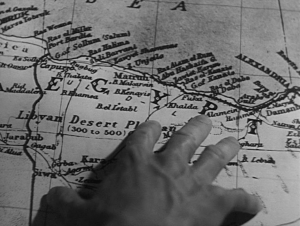
Similarly, since 1946, with the publication in France of “the two earliest essays on Hollywood film noir,” mass media journalists and academic historians haven’t seen what was fundamental in the origins of film noir, even though it was right in front of their eyes.2
Here, I offer a new interpretation about the beginning of film noir in Britain and the United States. Put simply, the earliest film noirs in these countries were spy films nearly as much as crime films. These “spy noirs” were mainly released during the Second World War era: in the UK, as of the mid-1930s; in the US, as of the late 1930s; and then winding down in both countries in the immediate years after the war ended.
Recognition of spy noirs makes undeniable the historical context of the WWII era in the origins of Anglo-American film noir. (This post doesn’t address French film noirs released during the same years that are focused on here.3)
Please see my accompanying four tables of UK and US spy noirs. For each country, one table presents spy noirs that are cited in film noir reference books, although they aren’t called “spy noirs.” Also, for each country, there is a table in which I identify spy noirs, based on my own judgment, that haven’t been named in any reference books. (My research shows that most UK and US spy films released during the WWII era aren’t spy noirs. Nonetheless, as my tables indicate, a significant number of UK and US spy films, according to my criteria, deserve to be recognized as spy noirs, despite not being cited as such in film noir reference books.)
Key to the Definition of Spy Noir: Visual Style
While not a condition of a crime film, any spy film, no matter how far removed from events in the real world, is unmistakably associated with politics. A spy film has at least one main character whose real identity is unknown to the political enemy and who is engaged in secret activity against that enemy, which is typically a rival nation. The laws that are broken in spy films, as with the lawbreakers themselves, are unlike those in crime films. In short, spy films are distinct from crime films.4
What differentiates spy noirs from other spy films is the same “noir visual style” (or “noir style”) that separates crime noirs from other crime films.5 Therefore, it stands to reason that spy films with the noir style comprise a unique category of film noir. It is on this basis that I use the term spy noir and counterpose it to crime noir.
Below there are photographs (screen-captures) from a range of UK and US spy noirs that show the noir style. Furthermore, there are videos (scene-captures) that underscore the validity of including UK and US spy noirs in the filmography of film noir.
Take the following scene in Five Graves to Cairo. During an air raid, everyone in the hotel seeks shelter in the basement. There, amidst the rubble from the previous air raid, a Nazi lieutenant (Peter van Eyck) discovers the corpse of the real Paul Davos. From the officer’s close questioning, Bramble realizes he is about to be killed for his impersonation. The ensuing chase through the hotel is a fine demonstration of the high quality of the noir visual style that is in spy noirs.
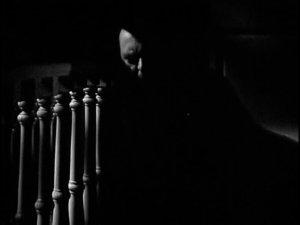 In Eyes in the Night, a blind man, “Mac” Maclain (Edward Arnold) prevents pro-Nazi fifth columnists from stealing the design for a secret airplane invention.
In Eyes in the Night, a blind man, “Mac” Maclain (Edward Arnold) prevents pro-Nazi fifth columnists from stealing the design for a secret airplane invention.
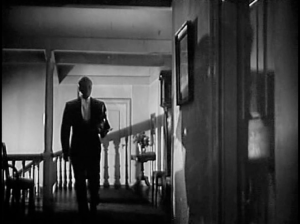 A butler, Hansen (Stanley Ridges), is Maclain’s main adversary. However, it is a woman (Katherine Emery) who is the ringleader.
A butler, Hansen (Stanley Ridges), is Maclain’s main adversary. However, it is a woman (Katherine Emery) who is the ringleader.
Spy films are included in several film noir reference guides, yet none of them recognizes spy noir as its own classification within film noir.6 My research indicates the number of spy noirs in these filmographies is less than half of the actual total. My own selections of UK and US spy noirs tend to exhibit at least as much – if not more – of the noir style as spy films cited in the reference books.
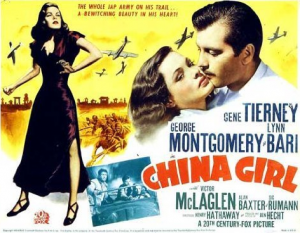
There have always been disagreements as to whether a particular crime film is or isn’t a film noir. I expect conflicting opinions about spy films. I acknowledge I have stronger selections (China Girl) and weaker ones (Conspiracy). Regardless, a sufficiently obvious and consistent noir style is evident in all of my choices. Spy films that lack an unambiguous noir style aren’t in my tables.
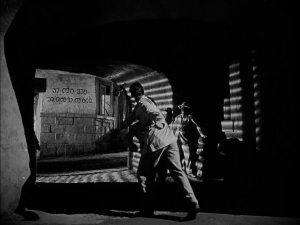 In China Girl, an American news photographer/pilot, Johnny Williams (George Montgomery), fights off thieves who want a valuable artifact that he is carrying on behalf a beautiful, enigmatic Chinese woman, Miss Haoli Young (Gene Tierney).
In China Girl, an American news photographer/pilot, Johnny Williams (George Montgomery), fights off thieves who want a valuable artifact that he is carrying on behalf a beautiful, enigmatic Chinese woman, Miss Haoli Young (Gene Tierney).
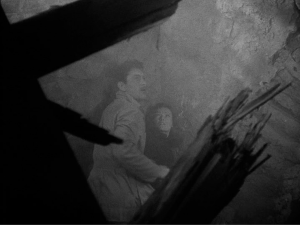 After Williams and Young fall in love, they survive a Japanese bombing raid. In a subsequent attack, Young is not as fortunate, and Williams converts from being unconcerned about the conflict to a warrior on China’s side.
After Williams and Young fall in love, they survive a Japanese bombing raid. In a subsequent attack, Young is not as fortunate, and Williams converts from being unconcerned about the conflict to a warrior on China’s side.
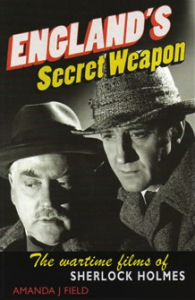 Of the hundreds of WWII-era spy films I analyzed, I was able to use the noir style as the criterion to discern which ones were spy noirs because there was never a doubt whether the story in any particular spy film was “noir” enough. That is, the plots and characters in spy films don’t need to be scrutinized to determine if they are adequately equivalent to those in crime noirs. For example, in England’s Secret Weapon: The Wartime Films of Sherlock Holmes, Amanda J. Field’s insight about Sherlock Holmes and the Voice of Terror suggests an essential difference between a crime film and a spy film.
Of the hundreds of WWII-era spy films I analyzed, I was able to use the noir style as the criterion to discern which ones were spy noirs because there was never a doubt whether the story in any particular spy film was “noir” enough. That is, the plots and characters in spy films don’t need to be scrutinized to determine if they are adequately equivalent to those in crime noirs. For example, in England’s Secret Weapon: The Wartime Films of Sherlock Holmes, Amanda J. Field’s insight about Sherlock Holmes and the Voice of Terror suggests an essential difference between a crime film and a spy film.
“If Holmes is serving the Allied cause, then it follows that his enemy will be the Nazis. This involves an interesting departure from the usual pattern of the classic detective genre, in which crime is assignable to one errant individual. In a war, the enemy is like the hydra – in cutting down one, a hundred more spring up to take its place.”7
Espionage means clandestinity, conspiracy and treachery. Film characters (and movie audiences) may only find out who is on which side in or near the last scene. During the WWII era, men and women, whatever their political allegiances, are at least as ruthless in spy noirs as crime noirs. Unsurprisingly, in these years, there is much more violence in spy noirs than crime noirs.8
The Five Main Types of Plots in Spy Noir
The main types of plots in spy noirs are as follows: Good Spies, Bad Spies, Resistance Fighters, Fifth Columnists, Converted to the Allied Cause.
For some films, of course, more than one type may be suitable. To illustrate a specific element of a plot type, I include one or more titles of relevant spy noirs.
Following each explanation of a plot type, I cite multiple titles of appropriate spy noirs from the UK and the US. These examples favor films with lead roles by women to highlight the significance and scope of females in spy noirs. (Throughout this post, titles in groups are named in the order of their release.)
I. Good Spies
The key undercover activity is by at least one spy who is British or American. Other good spies are trained government agents or if they are civilians, they are either working for their home country or acting on their own. This kind of spy is one of the following nationalities: Chinese, Czech, Dutch, French, Norwegian, Polish, or Russian.
A good spy is as likely to be a woman as a man. When someone is revealed in the finale to be a secret government agent, it is predictably a female. Here are eight examples.
Bulldog Drummond (John Lodge) believes a beautiful woman (Dorothy Mackaill) is a member of a spy ring. For example, he sees her put a drug in his tea to knock him out so that she can search his house for a piece of paper exposing the existence of the ring. (He “accidentally” spills the cup of tea.) In the penultimate scene of Bulldog Drummond at Bay, he discovers she is a British undercover agent who, like himself, is trying to bring down the spy ring. In the final scene she telephones her boss to say she is retiring and marrying Drummond. Her superior congratulates her, adding “But I should be very sorry to lose such a brilliant and charming officer.”9
British Intelligence, which takes place during WWI, has the most complicated disclosure of the good female spy. At first Helene von Lerbeer (Margaret Lindsay) is a German spy. For her outstanding service, the “Imperial Majesty” awards her a special bracelet. She also gets a new assignment and name. As “Frances Hautry,” supposedly a fugitive from a German detention camp, she is given sanctuary in the home of a British cabinet minister. There she meets the butler of the house, Valdar (Boris Karloff). The two acknowledge each other as fellow spies for the Kaiserreich. Later Valdar meets with members of British intelligence, suggesting that he is a double-agent. Back at the house, the newly arrived cabinet minister’s son recognizes Helene as the nurse he fell in love with when he was hospitalized in France. Valdar overhears Helene confess that she is working for the British secret service. Valdar is, in fact, the elusive German spymaster, Franz Shindler, who is the target of an elaborate British scheme to identify him. He is about to shoot Helene for being an enemy agent when she shows him the special bracelet. His belief in her loyalty to “the fatherland” restored, he reveals that he is Shindler. The film climaxes with Helene outing Shindler to the British secret service – she was all along the key to their plot to unmask him. In the final scene, a top official in British intelligence explains to the cabinet minister that no one but himself knew that Helene was so deep undercover.
In Navy Secrets, a woman (Fay Wray) and a man (Grant Withers) spend an evening together, at the end of which they bust up a spy ring. All along each of them had thought that the other was an enemy agent. At the conclusion they find out they are both in US Naval Intelligence. Still, the female is cleverer, more adventurous and assertive.
In Enemy Agent, a draftsman (Richard Cromwell) at an aircraft factory is smitten with a hostess (Helen Vinson) at a nearby steakhouse. Cromwell’s colleague (Vinton Hayworth) is in a gang of fifth columnists. He uses a camera disguised as a watch to photograph Cromwell’s top-secret designs for a bombsight. He also frames Cromwell, who is jailed. After Cromwell turns his romantic attention to a waitress at the steakhouse (Marjorie Reynolds), he tells her that he has proof Hayworth is a spy. Reynolds mentions this to Vinson, who searches Cromwell’s apartment and then his car, where she finds the evidence he had hidden there. After the fifth columnists are captured by FBI agents, we find out Vinson is one of them – she is a “G-[wo]man.”
The final scene of The Saint’s Vacation first shows, to the shock of his two companions, that Simon Templar (Hugh Sinclair) hadn’t tried to obtain a mysterious music box to sell for money but, instead, he did so on behalf of the British government. Next, it is The Saint’s turn be surprised when he discovers a woman (Leueen MacGrath), whom he thought was plotting against him to get the box, is in fact an official agent. Inside the box is a “gadget” that the government official, to whom The Saint hands over the box, secretly reveals the design for “an electric circuit which should give us [the UK] the best sound detector in the world.” This capability is so secret the official won’t let a news reporter (Sally Gray) phone in the story of “a lifetime.”
The audience knows very early in Escape from Hong Kong that Majorie Lord is not the German agent, “Fraulein K,” but that she is, in fact, a British undercover operative, “Valerie Hale.” However, her co-stars (Leo Carrillo, Andy Devine, and the romantic lead, Don Terry) are in the dark. Throughout the film, Terry does all he can to “hand her over to the British authorities.” Meanwhile, the British are after Lord for killing a British colonel. (The colonel was her handler and was the only one who knew her real identity. His murderer is a fellow British officer, “Major Reeves,” who is actually an imposter, a Nazi spy, Von Metz.) Whether he believes her or not about the murder, Terry’s conviction that Lord is working for the enemy leads him to badly undercut her efforts to complete her mission. As Terry reads a newspaper about the Japanese attack on Pearl Harbor, she says to him, “I’ve been working for the British. I’ve been posing as an Axis agent to discover who’s been giving information to the enemy.” He refuses to believe her. Instead, he turns her over to the imposter British officer, Von Metz. In the penultimate scene, Terry figures out that Lord was telling him the truth. In the climax, he, Carrillo and Devine prevent Von Metz from executing her. He asks, “Can you forgive me for being a dope?” Their romantic coupling ensues.
In Invisible Agent, the original Invisible Man’s grandson (Jon Hall) believes a lovely woman (Ilona Massey) that he has met – and who can’t see him – is a Nazi agent. Although he relies on her “training” to pilot a plane to get them from Germany to Britain, he thinks that if he lets her use the radio, she will inform the Nazis of their position instead of alerting the British not to fire at them with anti-aircraft guns. The plane is therefore shot down. While he recovers in a hospital from his parachute landing, the man (no longer invisible) is told that the woman is one of Britain’s “most trusted agents.” That is his revelation; hers is to see, at last, what the man she loves looks like.
In the penultimate scene of Madame Spy, famous war correspondent, David Bannister (Don Porter) calls the FBI to denounce his wife (Constance Bennett) as a member of a pro-Nazi spy ring. He then learns that his wife is an FBI undercover spy chiefly responsible for getting arrested all 33 men and women in the ring. The FBI agent says, “Man, do you realize you’re married to the cleverest, most delightful, most beautiful operative in our organization?” He replies, “I am?” The agent says, “Of course you are. It’s high time you found it out.” The marriage, which had seemed to be on the rocks, is now stronger than ever.
A good male spy, who is a British or American civilian, may pretend to be a different person whom he identically resembles. Not only does he fool the real man’s friends and accomplices but also his wife, girlfriend or mistress (Otto Beckner, Nazi Agent; Ralph Bellamy, The Great Impersonation; Jean-Pierre Aumont, Assignment in Brittany).
In each example below, the good spy is a woman.
UK – government agent: Vivian Leigh, Dark Journey; Valerie Hobson, Contraband (aka Blackout); Anna Neagle, Yellow Canary
UK – civilian: Wynne Gibson, The Crouching Beast; Margaretta Scott, The Man from Morocco
US – government agent: Margaret Tallichet, The Devil Pays Off; Nancy Coleman, Dangerously They Live; Vera Ralson, Storm Over Lisbon
US – civilian: Brenda Marshall, Espionage Agent; Veronica Lake, This Gun for Hire; Ingrid Bergman, Notorious
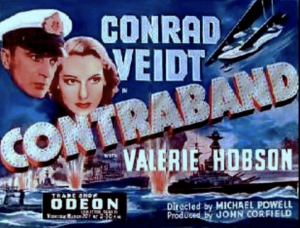
The following scene, presented in two parts, is a strong example of the noir style in the British spy noir, Contraband. It takes place in London in the underground hideout of a Nazi spy ring. In the first part, a Danish ship captain, Andersen (Conrad Veidt), and British secret agent, Mrs. Sorensen (Valerie Hobson), have been tied together and are being watched by the ring’s leader, Van Dyne (Raymond Lovell), whom they disparagingly call, “Mister Grimm.” When Hobson mentions “Mr. Pidgeon,” she is referring to her partner, who is still at large.
After Andersen and Sorensen trick Van Dyne into thinking they can’t escape from the rope that binds them, that is exactly what they do.
II. Bad Spies
The key undercover activity is by at least one spy who is German or Japanese. Note that before the US entered WWII, many films didn’t explicitly refer to Japan or Germany as the enemy. For example, take the first two US spy noirs from 1938. International Settlement opens with newsreel footage of military assault on China by land and air. A voice-over (from well-known broadcaster Lowell Thomas) says, “The beautiful city of Peiping finds itself helpless against modern warfare.” Before the film’s conclusion, there is a 17-minute scene of an aerial attack on Shanghai, with the city’s population fleeing from bombs, crumbling buildings and massive fires. In the WWII era, this is the most extensive intermixing of Hollywood studio film and newsreel footage to depict China’s plight. Yet, Japan is never mentioned. Similarly, in Blockade, neither side in the Spanish Civil War – the Nationalists (supported by German Nazis and Italian Fascists) nor the Republicans – is named. Hollywood studios did this to avoid being politically attacked by “isolationists,” as discussed below, and to retain access to the movie market in the Third Reich.10
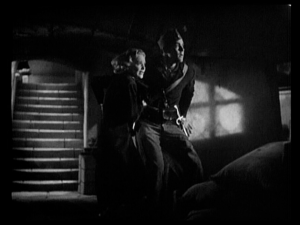 The first female star in both UK and US spy noirs was Madeleine Carroll. (See the Addendum below.) In Blockade, she and Henry Fonda survive a bombing raid by the unidentified enemy (i.e., fascists) on the civilians in a Spanish town. The film was released in June 1938, twelve months after Pablo Picasso painted Guernica.
The first female star in both UK and US spy noirs was Madeleine Carroll. (See the Addendum below.) In Blockade, she and Henry Fonda survive a bombing raid by the unidentified enemy (i.e., fascists) on the civilians in a Spanish town. The film was released in June 1938, twelve months after Pablo Picasso painted Guernica.
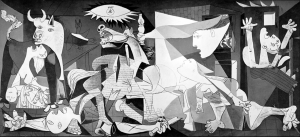 Guernica is the name of the village in northern Spain whose inhabitants, mainly women and children (most men were away fighting for the Republic), were attacked by German and Italian warplanes, at the request of the Nationalists, on 27 April 1937.
Guernica is the name of the village in northern Spain whose inhabitants, mainly women and children (most men were away fighting for the Republic), were attacked by German and Italian warplanes, at the request of the Nationalists, on 27 April 1937.
Bad spies are trained government agents or civilians who are recruited for espionage. A bad spy is as likely to be a woman as a man.
A bad male spy who masquerades as someone else based on physical resemblance is always German, never Japanese. He may be a natural double, with a proper accent, like the Prussian (Reginald Denny) who replaces a member of Britain’s elite and, on becoming a high government official, prepares a Nazi invasion of England (Sherlock Holmes and the Voice of Terror). Or he may use theatrical artifice, like the stage actor (Raymond Lovell) who, with make-up and the ability to mimic another person’s speech, impersonates an English aristocrat in a Nazi scheme to kidnap Winston Churchill (Warn That Man).
In the UK examples below, the bad spy is a man, and in the US examples the bad spy is a woman.
UK: Conrad Veidt, The Spy in Black; John Mills, Cottage to Let; Mervyn Johns, The Next of Kin
US: Ann Savage, The Lone Wolf Spy Hunt; Katherine Emery, Eyes in the Night; Veronica Lake, The Hour Before the Dawn
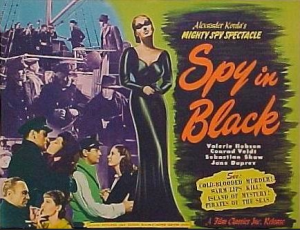 For an analysis of this spy noir, see the page The Spy in Black.
For an analysis of this spy noir, see the page The Spy in Black.
III. Resistance Fighters
The key underground activity is by resistance fighters who are on the side of the Allies. Like spies, if they are caught, they can expect to be put to death. They are Chinese (against the Japanese) or Czech, Dutch, French, Norwegian, Polish, and Yugoslavian (against the Germans).11
Although most resistance fighters are male, important leaders are often women. The underground may aid British or American servicemen to complete an espionage mission and/or escape from an occupied country (Anna Neagle, Nurse Edith Cavell; Annabella, Bomber’s Moon; Singe Hasso, The Seventh Cross).
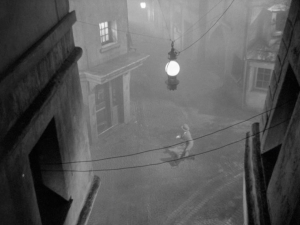 In The Seventh Cross, seven men are shown on the run after they flee from a Nazi concentration camp.
In The Seventh Cross, seven men are shown on the run after they flee from a Nazi concentration camp.
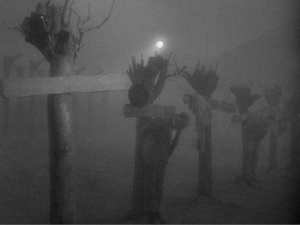 The film depicts how six of them, one by one, are captured and then lashed to makeshift crucifixes, on which they die.
The film depicts how six of them, one by one, are captured and then lashed to makeshift crucifixes, on which they die.
Only a single escapee, played by Spencer Tracy, gets away for good.
The Seventh Cross has one of the rare depictions of a Nazi concentration camp in a film released during the Second World War.12
Resistance may be with words instead of weapons. Because they courageously speak out against the Third Reich, the Nazis execute a minister (Wilfrid Lawson, Pastor Hall), a schoolteacher (Charles Laughton, This Land Is Mine) and two clandestine radio broadcasters (Clive Brook, Freedom Radio; Philip Dorn, Underground).
Compared with all other film noirs, the most gruesome acts of violence are committed in this type of spy noir. When women refuse to obey, fascists beat them (Above Suspicion, Underground), whip them (Hitler’s Children, Women in Bondage) or pull out their fingernails (Behind the Rising Sun).
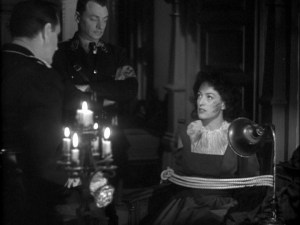 Joan Crawford is bound and beaten in Above Suspicion.
Joan Crawford is bound and beaten in Above Suspicion.
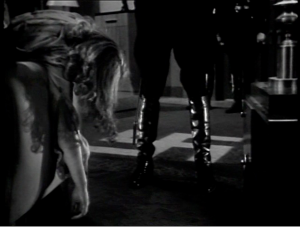 Kaaren Verne is beaten up in Underground. (A violinist in a Berlin cafe, she is also threatened with having her fingers broken, one by one.)
Kaaren Verne is beaten up in Underground. (A violinist in a Berlin cafe, she is also threatened with having her fingers broken, one by one.)
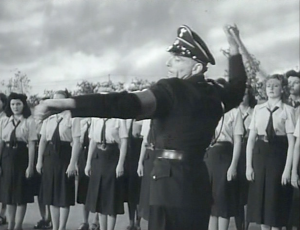
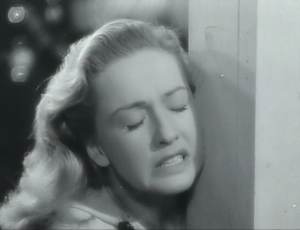 Bonita Granville, blouse torn open to expose her back, is flogged in Hitler’s Children.
Bonita Granville, blouse torn open to expose her back, is flogged in Hitler’s Children.
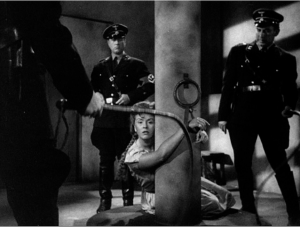 Nancy Kelly is whipped in Women in Bondage.
Nancy Kelly is whipped in Women in Bondage.
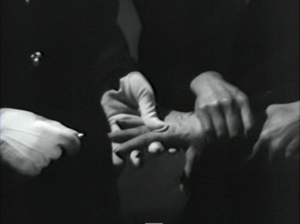
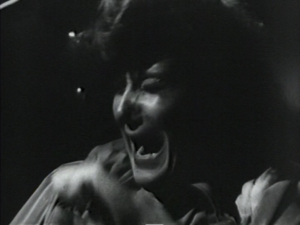 Gloria Holden’s fingernails are pulled out in Behind the Rising Sun.
Gloria Holden’s fingernails are pulled out in Behind the Rising Sun.
Females die keeping mum. Along with the shooting of the hotel maid (Anne Baxter) in Five Graves to Cairo (see Note 1), here are two other examples.
In Betrayal from the East, Peggy Harrison (Nancy Kelly) is in US Army Intelligence. As part of her “job” she has been the “girlfriend” of “a leading Nazi agent,” Kurt Guenther (Roland Varno). A Japanese fifth columnist, Mr. Araki (Hu Ho Chang), cannot get her to reveal her true identity and her connection with Eddie Carter (Lee Tracy), a civilian undercover operative helping the Army protect the Panama Canal. Guenther shoves Harrison into a steam room and raises the heat, expecting her to talk. She doesn’t, and her last words are, “Eddie, Eddie.”
In Confidential Agent, Else (Wanda Hendrix) is a 14-year old cleaning girl in a London hotel. When she refuses to reveal the location of papers critical to the Republicans in the Spanish Civil War, the pro-Fascist hotel manager, Mrs. Melandez (Katina Paxinou), pushes her out of an upper story window. Else’s scream lasts six seconds. Contreras (Peter Lorre), an accomplice to her death, later tells the “confidential agent,” Luis Denard (Charles Boyer), that Melandez said, “It was only one girl out of thousands. They die every day. It’s war.”
Axis pilots bomb and strafe defenseless populations, mass murdering women and children inside cities (North of Shanghai, Bombs Over Burma) or on country roads (Paris Calling, Reunion in France, China). Occupying forces threaten local civilians with death unless resistance fighters give themselves up. If the commoners refuse to betray their compatriots, they will be slaughtered (Hangmen Also Die!, Uncertain Glory).
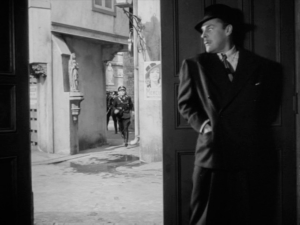 In Hangmen Also Die!, an assassin (Brian Donlevy) is chased by Nazis in one of two spy noirs about the killing of Reinhard Heydrich.
In Hangmen Also Die!, an assassin (Brian Donlevy) is chased by Nazis in one of two spy noirs about the killing of Reinhard Heydrich.
In retaliation for the murder of Reinhard Heydrich, the “Hangman of Prague,” near Lidice, Czechoslovakia (May 1942), a Nazi officer issues the following “proclamation” to the town’s inhabitants (Hitler’s Madman).13
“Upon orders of our Führer, the town of Lidice will be razed to the ground – her name to eradicated from every signpost, from all maps of the country and from the memory of all mankind – an atonement for the assassination of his excellency Reinhard Heydrich, Protector of Czechoslovakia. All male inhabitants over 16 years of age will be shot; all women interned in concentration camps; all children will be taken from their mothers and placed in correctional institutions; all livestock will be confiscated for the use by the German army. Attention! Fire the houses! Load the trucks! The executions will take place in the churchyard!”
The orders are carried out: the children are pulled away from their mothers; the women are herded on trucks; and the men are marched to a churchyard, where, while they defiantly sing, they are mowed down.
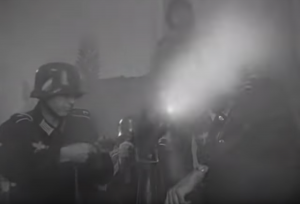 As in Hitler’s Madman, the most gruesome extermination of innocent civilians is by machine guns (China Girl, Tomorrow We Live, Assignment in Brittany, Hostages).
As in Hitler’s Madman, the most gruesome extermination of innocent civilians is by machine guns (China Girl, Tomorrow We Live, Assignment in Brittany, Hostages).
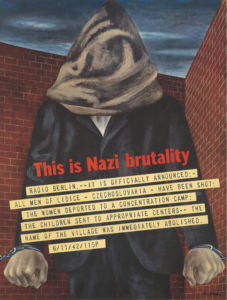 This is Nazi Brutality (1942) was Ben Shahn’s response to the massacre in Lidice, an offset lithograph poster issued by the US Office of War information.
This is Nazi Brutality (1942) was Ben Shahn’s response to the massacre in Lidice, an offset lithograph poster issued by the US Office of War information.
In other spy noirs, firing squads use rifles. After a French woman (Annabella) informs on a good spy, her parents are shot nonetheless (Tonight We Raid Calais). Five boys admit to a Nazi officer that they helped their schoolmistress (Mary Morris) escape to join the Yugoslavian partisans. The officer tells one of the students, “I’m going to plant a picture in your mind you’ll carry with you all your life.” The youth must watch as his four friends, plus two randomly picked classmates, are summarily executed in the schoolyard (Undercover).
In The Conspirators, a Dutch resistance fighter (Paul Henreid) tells the following story to several Portuguese in a fishing village:
“I was a schoolteacher in Holland. One morning I was writing a lesson on the blackboard – the Nazis came. They came so suddenly I didn’t have time to know what was happening. There were dead people in the streets, and a military band in the square. One of my pupils, a 14-year old boy, jumped to the blackboard and wrote three words it. ‘Long live liberty.’ A German officer shot that boy and arrested me. He arrested me for teaching dangerous thoughts. But I escaped. Those who escape learn to hide, to do without food, without sleep, without rest. They also learn to throw bombs and cut wires, to blow up trains and destroy power stations. Many times a message is left, so that when the Germans reach the scene, all they find is a wreck and a piece of paper with three words on it – the words that 14-year old boy wrote on the blackboard. ‘Long live liberty.'”
The following scene in Tonight We Raid Calais is presented in two parts. In the first, a French woman (Annabella) reveals a military secret to a Nazi Captain (Richard Derr) because he promises to spare the lives of her parents. Four other village women, Resistance fighters, are preparing Molotov cocktails. The fires they set off will burn the fields that surround a munitions factory. The flames will guide RAF planes to bomb the correct buildings, instead of decoys the Germans have constructed.
The second part indicates why the woman changes her mind about the war and converts to supporting Allied cause.
In Lady from Chungking, the Japanese “overseer” of Chinese “coolies” in a rice field is found murdered. A general (Harold Huber) wants a firing squad to kill everyone who was working in the field. The secret leader of the Chinese resistance (Anna May Wong), with her beauty and cultured manners, has won the general’s love and respect. As he is about to order the first execution, she suggests that he should spare the young workers or else his own troops will have to toil in the rice fields. Although she saves these lives, the elderly cannot escape the general’s retribution. He says, “Let the young ones see that for their crimes their fathers will pay.” She sits and watches, barely holding back her tears, as the village’s old men are shot, “two at a time; it saves ammunition.”
In spy noirs about resistance fighters, there are many female victims of sexual assault. Teenage girls commit suicide after they are raped (Hotel Imperial, Pastor Hall, China) – or beforehand. In Hitler’s Madman, the “Hangman” (John Carradine) chooses young Czech coeds to be sent to the Russian front “to entertain our courageous German soldiers.” Before one of them can “be examined like cattle,” she jumps off a window ledge several stories high.
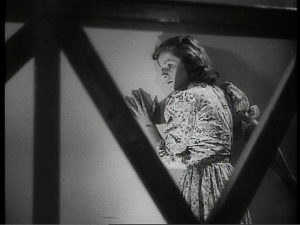 In Pastor Hall, a 14-year old German girl (Lina Barrie) is raped and abandoned by a Nazi youth leader. Now pregnant, she overhears that her neighbors scorn her. Moments later, she hangs herself.
In Pastor Hall, a 14-year old German girl (Lina Barrie) is raped and abandoned by a Nazi youth leader. Now pregnant, she overhears that her neighbors scorn her. Moments later, she hangs herself.
In Behind the Rising Sun, a Japanese soldier grabs a Chinese boy from his mother and throws him up in the air so that he will fall on a bayonet. In another scene, one soldier removes a baby from its mother, and two others take her back inside her house and shut the door. Above the screaming infant there is a flyer that says, “PROCLAMATION! ALL women in this area will remain at home until further notice. All women will welcome all Japanese soldiers.”
In Edge of Darkness, a Norwegian village is under the jackboot of a Nazi battalion and a merciless commandant (Helmut Dantine). To forestall a revolt, he issues an order, “All restrictions on our troops are to be lifted. They are free to do in this town as they please.” After a soldier rapes a woman (Ann Sheridan), who is a leader of the underground, her father (Walter Huston) kills the rapist. The woman, her father and the others in the resistance are ordered to dig their own mass grave. Just before they are shot, the townsfolk launch the revolt. When the mutual slaughter is over, the village is depopulated – the corpses of hundreds of Nazis and Norwegians lie in heaps wherever the camera pans. With his troops all dead, the commandant blows out his brains. A handful of locals who survive, including the raped woman, continue their anti-fascist fight as guerrillas based in forests.
Rape isn’t the only way females are sexually violated. In Women in Bondage, according to “the principle guiding the life and existence of all Hitler women and Hitler girls…children and ever more children will make the Reich eternal.” A girl (Nancy Kelly) in this film who won’t submit to assembly line reproduction is executed.
At a Prague restaurant next to the Vitava River in Hostages, a drunken and sobbing Nazi lieutenant (Hans Conreid) says to a washroom attendant, “It’s more than a man can bear. The girl I was to marry – they’ve sent her to a breeding colony.” Once he is alone, the officer drowns himself.
In Hitler’s Children, the “breeding colony” is called the “rest home” at a “labor camp.” In fact, the Nazis’s own term was Lebensborn (fount or fountain of life).14 A young woman (Bonita Granville) gives a tour to her former professor Nichols (Kent Smith). A Nazi lieutenant (Tim Holt) says that the young females “are drafted to serve just as men are in the army. And they serve just as proudly.” The woman, who has yet to reveal her opposition to the New Order, adds, “They work hard and live simply to fit them for their duties to the state. The only recreation provided is the Saturday night dance. There, lovers may meet and decide to share the experience that makes them worthy of the Führer.” The scene continues below.
Before the US entered the war, the role of Nazi women to birth future soldiers wasn’t dealt with so critically, but instead discreetly. In one of the earliest US spy noirs, Confessions of a Nazi Spy (1939), the American Third Reich leader asks a pubescent girl at a Nazi youth rally, “What are the ideals of German womanhood?” She answers, “To be of service to our Führer. To be the custodian of our children until they shall be called unto arms.”
In Hitler’s Children, as they look down at a large surgery room, a Nazi colonel (Otto Kruger) says the following to the professor.
“This, professor, is a most unusual clinic. In fact, the most unusual. One of the finest of its kind in the world. You are observing what is probably the most progressive medical advance ever attempted by any government. All these patients are women, women who are unfit to have children. They are being sterilized…We are building a new Germany, a strong Germany. There is no room for sick and the weak and the unstable…Of course, although the majority of cases are the weak and the unstable, our doctors operate for a number of other reasons. Would you believe it, professor, they range from eliminating hereditary color blindness to dangerous political thinking. In political cases it makes the woman much quieter, more reasonable. It is sometimes much kinder than putting a woman in a concentration camp.”
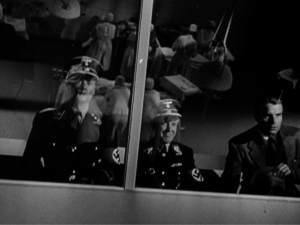 A lieutenant (Tim Holt), dedicated to Hitler since his youth, becomes so revolted by his superior’s cold-blooded description of the practices at the “Fräulein Clinic” that he turns against the Third Reich. In the climax of Hitler’s Children, he is shot as a traitor. Immediately afterwards, the woman (Bonita Granville) he has loved since they were teenagers, is killed for her own disloyalty.
A lieutenant (Tim Holt), dedicated to Hitler since his youth, becomes so revolted by his superior’s cold-blooded description of the practices at the “Fräulein Clinic” that he turns against the Third Reich. In the climax of Hitler’s Children, he is shot as a traitor. Immediately afterwards, the woman (Bonita Granville) he has loved since they were teenagers, is killed for her own disloyalty.
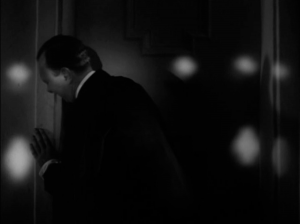 In The Silver Fleet, a wife (Googie Withers) locks her husband (Ralph Richardson) out of their bedroom because she believes he is a Nazi collaborator. Later, she reads his diary and discovers how he made himself a martyr for the Dutch resistance.
In The Silver Fleet, a wife (Googie Withers) locks her husband (Ralph Richardson) out of their bedroom because she believes he is a Nazi collaborator. Later, she reads his diary and discovers how he made himself a martyr for the Dutch resistance.
An unusual spy noir is about a resistance fighter who isn’t plausible as a realistic character in a war story. Thus, he is different from almost all other characters in spy noirs (but not, for example, from the son of the Invisible Man in Invisible Agent). Leslie Howard directs and stars in “Pimpernel” Smith, in which he is a professor of archaeology at Cambridge University, as well as secretly a mastermind at liberating Nazi prisoners. The introduction to the film says:
“The tale we are about to unfold to you is a fantasy. None of its characters are living persons. But it is based on the exploits of a number of courageous men who were and still are risking their lives daily to aid those unfortunate people of many nationalities who are being persecuted and exterminated by the Nazis. To these champions of freedom this story is dedicated.”
Reichminister General Von Graum (Francis L. Sullivan) is so vexed by Smith, “this mysterious rescuer,” that he dedicates himself to discovering the identity of the elusive “Pimpernel” and executing him. The climax of the film is outstanding.
In the first example below the resistance is by an English village against an invasion of Nazi paratroopers; in the second it is by a Dutchman who designs a U-boat; and in the other four examples the central character is a woman.
UK: Went the Day Well?; Ralph Richardson, The Silver Fleet; Patricia Burke, The Lisbon Story
US: Linda Hayes, Conspiracy; Nancy Coleman, Desperate Journey; Merle Oberon, First Comes Courage
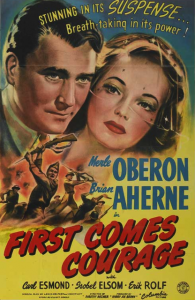
IV. Fifth Columnists
The key secret activity is by fifth columnists, who are, generally speaking, a group of people that, overtly or covertly, act in support of an enemy of their own country.15 In spy noirs, every ring of fifth columnists is mostly male, but the ringleader is often a woman.
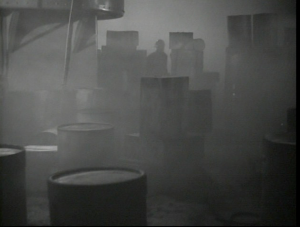 In Secret Command, an undercover federal agent, Sam Gallagher (Pat O’Brien), has a partner, Jill McGann (Carole Landis), who pretends to be his wife. Their mission is to bust up a ring of pro-Nazi fifth columnists who aim at sabotaging the shipyard where Gallagher’s brother (Chester Morris) is the foreman. In the climax, Gallagher hunts the ringleader in the fog on the ship that is set to explode and blow up the shipyard.
In Secret Command, an undercover federal agent, Sam Gallagher (Pat O’Brien), has a partner, Jill McGann (Carole Landis), who pretends to be his wife. Their mission is to bust up a ring of pro-Nazi fifth columnists who aim at sabotaging the shipyard where Gallagher’s brother (Chester Morris) is the foreman. In the climax, Gallagher hunts the ringleader in the fog on the ship that is set to explode and blow up the shipyard.
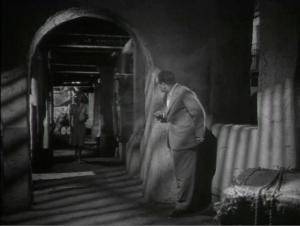 In Tampico, an American ship captain (Edward G. Robinson) believes that the approaching woman is not only a Nazi agent but also his wife.
In Tampico, an American ship captain (Edward G. Robinson) believes that the approaching woman is not only a Nazi agent but also his wife.
Literally, one of the darkest scenes in spy noir is the climax of Unpublished Story. Two journalists, Bob Randall and Carol Bennett (Richard Greene and Valerie Hobson) are working together to expose a “pacifist” organization as a front group for the Nazis. One member of the “People for Peace,” Trapes (Frederick Cooper), becomes disillusioned and sends Bennett a letter denouncing it. So naïve is Trapes that he tells what he has done to the fascists. Just before Randall and Bennett arrive at a London train station, British counter-intelligence agents set up Trapes as the bait to lure the Nazis out into the open. Their plan is that Trapes won’t be killed, but the Nazis will be captured. The title of the film derives from final scene when the chief of the British agents (Basil Radford) tells the reporters that, in “the public interest” (i.e., to prevent the public from being frightened to learn that Nazi agents have been at large on home soil), their scoop can’t be printed.
A film’s central characters may be the opponents of fifth columnists – good civilians or good government agents. For example, when fifth columnists commit a crime that the police blame on an innocent man, the lead roles belong to the accused and a woman who is critical to proving he isn’t guilty. In the WWII era, there are many crime noirs featuring a hunted man whose “ally” is a woman with a job.16 However, this plot “formula” is even more frequent in spy noirs: Man Hunt, Meet Boston Blackie, Pacific Blackout, All Through the Night, Fly-By-Night, Little Tokyo, U.S.A., Saboteur, This Gun for Hire, The Gorilla Man, Hangmen Also Die!, Journey Into Fear, The Conspirators, Ministry of Fear, Waterfront. For a full exposition of the hunted man and his working class ally in the WWII era in both spy noirs and crime noirs, see the page Film Noir Plot Elements: WWII vs. Postwar.
While it may be the rule that British and American authorities only round up and put away actual fifth columnists, there is an infamous and historically true exception. At the end of Little Tokyo, U.S.A., we see documentary footage of Japanese in Los Angeles, their belongings piled high on sidewalks, waiting to be transported to internment camps. A newspaper headline says, “LAST JAPS LEAVE L.A. AREA TODAY – Military Area Cleared of Possible Saboteurs.” With a long line of buses on the move in the background, a female radio announcer (Brenda Joyce) faces us and speaks into her microphone, “And so, in the interest of national safety, all Japanese, whether citizens or not, are being evacuated from strategic military zones on the Pacific coast. Unfortunately, in time of war, the loyal must suffer inconvenience with the disloyal.” Additional justification for the internment is given earlier in the film when the Japanese-American head of “the operations in southern California” (Harold Huber) says to an American fifth columnist (Donald Douglass), “Mass evacuation, as you know, will defeat our plan of operation here.”17
In the first two US examples below, the hero is a civilian (medical intern, aircraft worker), and in the third he is a secret federal operator (shipyard worker). Each man successfully smashes a ring of fifth columnists with the close aid of a woman – an undercover UK and US agent (Nancy Coleman, Carole Landis), respectively, in the first and third films, and a billboard model (Priscilla Lane) in the second.
UK: Robert Donat, The 39 Steps; Bruce Cabot, Traitor Spy; Roger Livesey, Spies of the Air
US: John Garfield, Dangerously They Live; Robert Cummings, Saboteur; Pat O’Brien, Secret Command
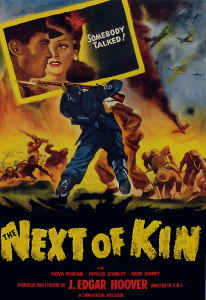
V. Converted to the Allied Cause
In this plot type a man or a woman is at first either unconcerned with or opposed to the UK or US winning the war. Due to their subsequent experiences, they change their minds and take sides against Germany or Japan.18 At the end of the film they may still be fighting or they may have sacrificed their lives.
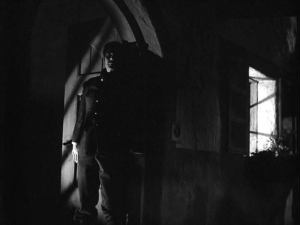 In Four Sons, an anti-Nazi in Germany (Don Ameche) is betrayed by his sister-in-law (Mary Beth Hughes). Much later, realizing she has supported the wrong side, she leaves Germany to keep her son from being called up to the Wehrmacht.
In Four Sons, an anti-Nazi in Germany (Don Ameche) is betrayed by his sister-in-law (Mary Beth Hughes). Much later, realizing she has supported the wrong side, she leaves Germany to keep her son from being called up to the Wehrmacht.
In Tonight We Raid Calais, before her conversion, it is especially poignant why a local woman (Annabella) not only refuses to assist a British commando with his mission but is willing to betray him to the Nazis. Her brother was among 1297 servicemen killed on 3 July 1940, when the British bombed the French fleet at the port of Mers-el-Kébir, outside Oran, Algeria.19 Since her brother’s wife is also dead, she has assumed responsibility for raising his orphaned son.
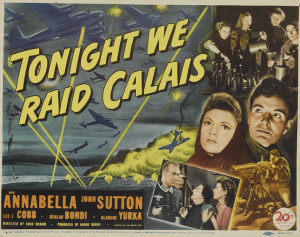
Two older men who once believed, respectively, in the New Order in Germany and Japan, come to realize it is abhorrent. In the climax, one faces execution (Paul Lukas, Address Unknown), and the other commits hara-kiri (J. Carrol Naish, Behind the Rising Sun). Crucial to each man’s conversion is the tragedy that occurs to a young woman who was going to marry the man’s son.
In Address Unknown, the fiancé (K. T. Stevens) is to star in a performance of the Passion Play in Berlin. An agent of the Department of Censorship orders certain lines of Christianity to be deleted, such as, “The meek shall inherit the earth.” He warns, “Disobedience is treason.” When the woman speaks the forbidden words, the agent stops the show and reveals her secret to the full house – she is a Jew. In the scene below, the revelation whips the audience into a frenzy, and it charges the stage after her and chases her through the streets. (At the end of the scene, note the J painted on the door.)
With the crowd hunting her in Berlin, she flees from the city. Closely pursued by Nazi police over marshlands and through woods, she reaches the home of the man who once was to be her father-in-law (Paul Lukas). After he refuses to help her so that the Nazis can kill her (note her bloody handprint inside his front door), he tries to prevent his wife (Mady Christians) from crying out her name, “Griselle,” a second time.
In Behind the Rising Sun, the father (J. Carrol Naish) has a son (Tom Neal) who is a Japanese army colonel. He and his fiancé (Margo) accidentally discover that her parents have sold “little sister” to Yoshiwara, the historic red light district in Tokyo. At first the colonel is proud of the girl for making “a wonderful sacrifice.” Then, war is announced between Japan and the US. As the woman searches for her sister to “buy her back,” she is arrested on trumped up charges of being a spy. Her crime is friendship with three Americans (Robert Ryan, Gloria Holden, Donald Douglas), who are also accused of espionage. To get confessions, they are tortured – one of them to death (Ryan). At a kangaroo court, the colonel renounces his fiancé, and his testimony seems to seal her fate for capital punishment.
In the two UK examples below, the converted is first a French working-class woman and then one who is Irish; in the first US example, it is a female German aristocrat; and then in the next two examples, it is a male American ex-patriot entrepreneur (first a nightclub owner and then a freelance pilot).
UK: Carla Lehman, Secret Mission; Deborah Kerr, I See a Dark Stranger
US: Norma Shearer, Escape; Humphrey Bogart, Casablanca; George Montgomery, China Girl
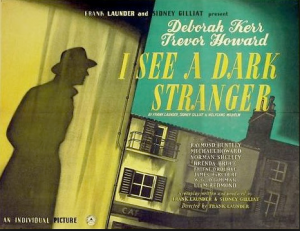
Three Key Aspects of Spy Noir
I. International from the Start
Spy noirs, from their first years, were released both in Britain and the United States. Spy noir begins as international and, therefore, film noir shouldn’t be defined as uniquely American. (See Note 3 for filmographies of early French film noirs.)
II. Spy Noirs Begin before 1940, Principally in Great Britain
There is no consensus on the time frame of film noir. While it was once customary to start “the classic period” in 1940, there are filmographies with film noirs from the 1930s. For example, John Grant includes UK and US film noirs from the 1930s (plus more released in other countries in that decade). Michael F. Keaney’s earliest British film noirs are in the late 1930s; and there are British film noirs throughout the 1930s in Robert Murphy’s list.20
As my tables indicate, in 1939, the year WWII begins in Europe, the release of spy noirs takes off in Britain and, especially, America.
John Grant and Robert Murphy are the only historians whose filmographies include pre-1939 spy noirs, and all of them are British. They both name The Man Who Knew Too Much and Sabotage (aka The Woman Alone), and Murphy adds Dark Journey and Strange Boarders.
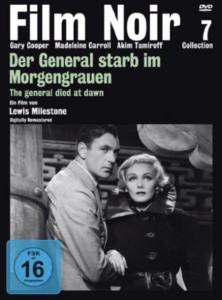 I include seven more from the UK: The Crouching Beast, The 39 Steps, Secret Agent, The Secret of Stamboul (aka The Spy in White), Bulldog Drummond at Bay, I Married a Spy (aka Secret Lives), Under Secret Orders.
I include seven more from the UK: The Crouching Beast, The 39 Steps, Secret Agent, The Secret of Stamboul (aka The Spy in White), Bulldog Drummond at Bay, I Married a Spy (aka Secret Lives), Under Secret Orders.
I also cite the five pre-1939 US spy noirs: The General Died at Dawn, Blockade, Bulldog Drummond in Africa, International Settlement, Mr. Wong, Detective.
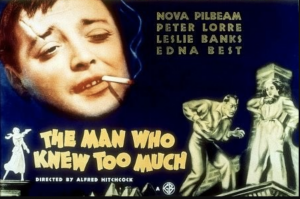
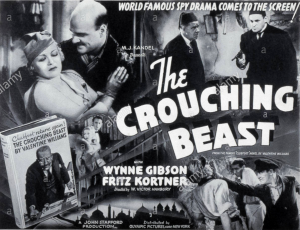
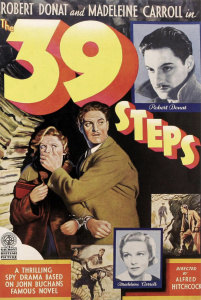
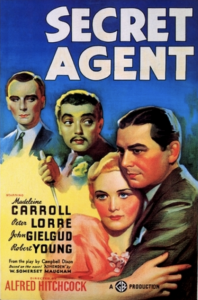
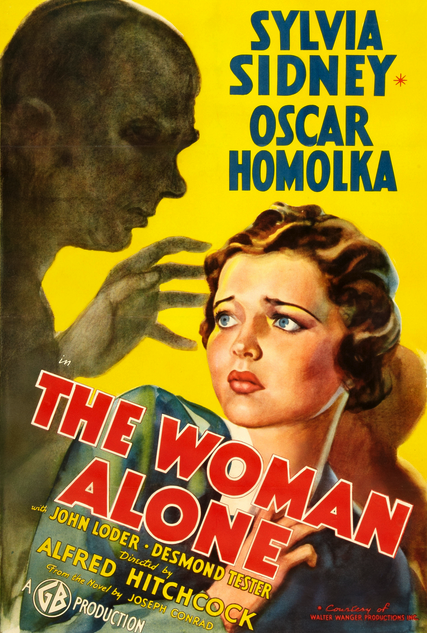
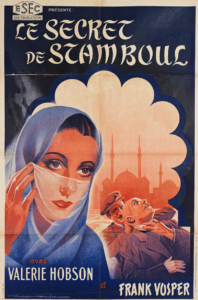
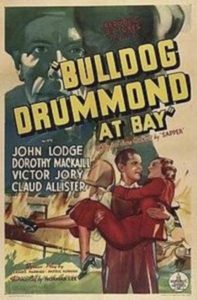
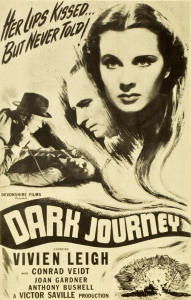
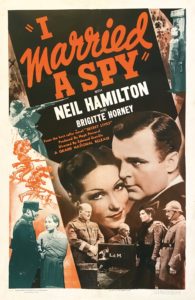
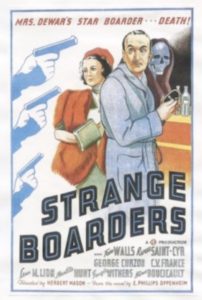
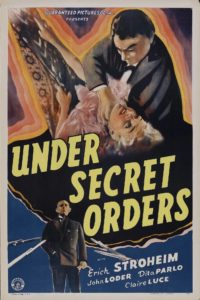
For an analysis of this spy noir, see the page Under Secret Orders.
III. Greater Gender Equality
In crime noir, women have been repeatedly categorized in specific and limited ways. For example, Jon Tuska’s opinion is representative.
“There are two basic kinds of women in film noir, with a third, subsidiary type only occasionally present. The two basic types are the femme fatales and the loving wives and mothers…The third type of noir woman is the beautiful neurotic. She is not found as often as the femme fatale, but when she is, as in Sorry, Wrong Number (Paramount, 1948), she is still the primum mobile which brings both herself and the noir male protagonist to catastrophe.”21
For a comprehensive explanation of the most frequent female character in film noir — the woman is distress, who appears, for example, in many more crime noirs than a femme fatale — see the page Significance of the Woman in Distress. For evidence that a woman in distress is in many more crime noirs than a femme fatale, see the table in the page Woman in Distress vs. Femme Fatale.
Unlike women in crime noirs, women in spy noirs play nearly all the same roles as men. There are female airplane pilots, newspaper reporters, radio broadcasters, underground resistance fighters, fifth columnist ringleaders, good and bad secret agents, and so on. In Candlelight in Algeria, this is the way a woman (Carla Lehmann) expresses her self-consciousness that women are the equals of men, “The only job a man can do that a woman can’t is to grow a mustache.”
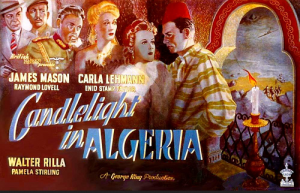
The greater gender equality in spy noirs is due to its historical period, the WWII era. British and American women markedly contributed on the home front and in the armed forces. With increased economic and social independence, women were a different kind of movie audience than they had ever been before. Accordingly, the studios responded with plots and characters more appealing to and appropriate for these self-confident females.22
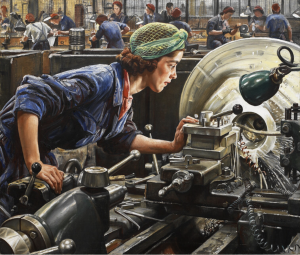 The female war worker in Laura Knight’s painting, Ruby Loftus Screwing a Breech Ring (1943), was Britain’s Rosie the Riveter.22
The female war worker in Laura Knight’s painting, Ruby Loftus Screwing a Breech Ring (1943), was Britain’s Rosie the Riveter.22
A woman shows how the resistance struggle is her highest priority when she doesn’t accompany a man back to America or Britain, where their love affair could safely continue: Lilli Palmer, Cloak and Dagger; Linda Hayes, Conspiracy; Nancy Coleman, Desperate Journey; Norma Shearer, Escape; Merle Oberon, First Comes Courage; Patricia Burke, The Lisbon Story; Joan Crawford, Reunion in France; Carla Lehman, Secret Mission; Vera Ralson, Storm Over Lisbon; Annabella, Tonight We Raid Calais. At the end of the film, she remains where she is to keep on with the “secret war” against the Nazis.
For example, in the conclusion of Tonight We Raid Calais, the women seen in an earlier clip have succeeded in setting fires around the Germans’ munitions factory, and RAF bombers have destroyed it. One of them (Annabella), now converted to the Allied cause after she witnessed Nazis gun down her parents, asks a British commando (John Sutton) to take her orphaned nephew with him to England. She will stay behind with the other women.
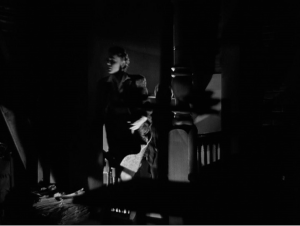 In Desperate Journey, a woman in the anti-fascist underground (Nancy Coleman), helps RAF crewmen escape from Germany after their plane is shot down. The squadron leader (Errol Flynn) wants her to come with his team to Britain. She declines. He says, “But you’ve done your share and more.” She says, “No one’s share will be done until the war is over. There will be other men, from the prison camps, the concentration camps, the conquered countries. It’s our job – the job of the underground – to return them to the fight. We must all do our work before we can go back to doing what we like.”
In Desperate Journey, a woman in the anti-fascist underground (Nancy Coleman), helps RAF crewmen escape from Germany after their plane is shot down. The squadron leader (Errol Flynn) wants her to come with his team to Britain. She declines. He says, “But you’ve done your share and more.” She says, “No one’s share will be done until the war is over. There will be other men, from the prison camps, the concentration camps, the conquered countries. It’s our job – the job of the underground – to return them to the fight. We must all do our work before we can go back to doing what we like.”
As was actually happening between couples in the UK and the US, romance is put on hold for the duration. In Escape, a countess (Norma Shearer) insists on staying in Germany so that her former lover, a Wehrmacht general (Conrad Veidt), cannot “torture” two local residents who enabled her new American lover (Robert Taylor) to get across the border. She promises to meet the Yank later “on 57th. Street.”
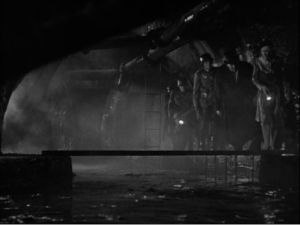 In Joan of Paris, the cleverness and sacrifice of a woman (Michèle Morgan) saves four British RAF crewmen (featuring Paul Henreid and Alan Ladd) from a Gestapo chief (Laird Cregar) and his squad of soldiers.
In Joan of Paris, the cleverness and sacrifice of a woman (Michèle Morgan) saves four British RAF crewmen (featuring Paul Henreid and Alan Ladd) from a Gestapo chief (Laird Cregar) and his squad of soldiers.
Behind the Rising Sun presents quite different circumstances but with a similar outcome. Three innocent people are about to be executed as spies on trumped up charges: two Americans in love with each other, a newspaperwoman (Gloria Holden) and an engineer (Donald Douglas), and the engineer’s Japanese secretary (Margo). While Tokyo is being bombed by US warplanes, the three are rescued and driven out of the city in the limousine of their friend (J. Carrol Naish), who is a government cabinet minister. The plan is for them to be flown to America. Abruptly, Margo asks the driver to stop the car. Before she gets out, she says to Holden and Douglas, “All my life I’ve wanted to go to America. But that must wait now. My place is here. I know that there isn’t much that I can do alone, but someday perhaps we will be delivered by those who are free, and it will be important that there are some of us here who understand the world outside and a few outside who understand Japan – the Japan that is yet to be born.”
In spy noirs, there are not only true romances but also false ones. Whereas men don’t do it, women go under covers and sleep with the enemy. When she is a wife, she outlives her husband and then has real love with another man, who is a hero on her side (Elisabeth Bergner, Paris Calling; Merle Oberon, First Comes Courage; Margaretta Scott, The Man from Morocco; Ingrid Bergman, Notorious). When she is a mistress in later spy noirs, the man kills her in revenge for her duplicity (Anna May Wong, Lady from Chungking; Evelyn Ankers, Sherlock Holmes and the Voice of Terror; Nancy Coleman, Edge of Darkness). In The Spy in Black, a female British secret agent (Valerie Hobson) pretends to be a German spy. She tells a real German spy (Conrad Veidt) that, in order to make plans to destroy a British fleet, they are getting help from “a British naval officer with a grudge against the service.” He has no objection or regret when she says the traitor’s “rather high” price was paid by Germany “and me.” (For an in-depth analysis, see the page The Spy in Black.)
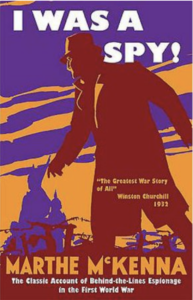 Before the films named above were released, Madeleine Carroll had already been pimped twice. In the UK spy film, I Was a Spy, Carroll, a Belgian nurse living under German occupation during WWI, is urged by her lover and espionage partner (Herbert Marshall) to accept the offer to take a trip and thereby sleep with the town Kommandant (Conrad Veidt) in order to get him to reveal classified information. Once Veidt obtains evidence that Carroll is a spy, despite his own unhappiness, since he also loves her, he follows his duty, arrests her and demands that a military tribunal have her executed. Instead, her life is spared when Marshall sacrifices his own, and she is imprisoned until Belgium is liberated. Published a year earlier, in 1932, I Was a Spy! is the title of the memoirs of the real undercover life of Marthe Cnockaert, whose deception was so successful that, before being exposed, she was awarded Germany’s Iron Cross. The film opens with this statement, excerpted from the book’s Foreword:
Before the films named above were released, Madeleine Carroll had already been pimped twice. In the UK spy film, I Was a Spy, Carroll, a Belgian nurse living under German occupation during WWI, is urged by her lover and espionage partner (Herbert Marshall) to accept the offer to take a trip and thereby sleep with the town Kommandant (Conrad Veidt) in order to get him to reveal classified information. Once Veidt obtains evidence that Carroll is a spy, despite his own unhappiness, since he also loves her, he follows his duty, arrests her and demands that a military tribunal have her executed. Instead, her life is spared when Marshall sacrifices his own, and she is imprisoned until Belgium is liberated. Published a year earlier, in 1932, I Was a Spy! is the title of the memoirs of the real undercover life of Marthe Cnockaert, whose deception was so successful that, before being exposed, she was awarded Germany’s Iron Cross. The film opens with this statement, excerpted from the book’s Foreword:
“Self-preservation has forced States and armies in every age to exact the penalty of death from a spy. A Secret Service Agent who is not actuated by any sordid motive, but inspired by patriotism, and ready to pay the well-known forfeit, deserves respect and honour from those he serves so faithfully. Marthe Cnockaert fulfilled in every respect the conditions which make the terrible profession of a spy dignified and honourable.
“Rt. Hon. Winston S. Churchill, P.C., C.H., M.P. (Secretary of State for War, 1918-1921)”
In The General Died at Dawn, Carroll’s father (Porter Hall) whines that because he is dying, he wants money to return to America for his final “six months.” Browbeaten and guilt-tripped, Carroll obeys her father’s wishes and seduces Gary Cooper into taking a train (which he knows is dangerous) instead of a plane (which would be much safer). What is the difference? On the train he is vulnerable to being robbed of a belt that holds a lot of money raised from Chinese peasants to buy guns and ammunition to repel a warlord, General Yang (Akim Tamiroff), who is oppressing (and killing) them. Carroll understands, according to her father’s plan, Yang is going to board the train, take away the money belt from Cooper, and then kill him. Nursing a hatred of Carroll (since losing the money means he failed the peasants who had raised it), Cooper manages to escape from Tamiroff and his soldiers and goes after Carroll to recover the belt. Carroll, meanwhile, despairs of her role in helping her father. By the end of The General Died at Dawn, not only Yang but also her father are dead, and Carroll and Cooper have reconciled and are romantically coupled. Released in October 1936, this film is the first US spy noir, and Carroll is the first femme fatale in all of film noir (whether from France, the UK or the US). She isn’t a “hard” femme fatale, but a “soft” one. For an explanation about the soft femme fatale vs. hard femme fatale, see the page International Lady.
Besides I Was a Spy, there are three spy noirs, based on actual events, about women in espionage: Under Secret Orders, Nurse Edith Cavell and Paris Underground.
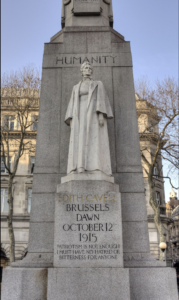
For an in-depth analysis of the three 1930s films based on the WWI German secret agent, Elsbeth Schragmüller, see the page Under Secret Orders. In this film, Dita Parlo is the first “hard” femme fatale in all of film noir (from France, the UK or the US).
Nurse Edith Cavell recounts the true story of a British nurse, played by Anna Neagle. She and three female friends help “about 200” British soldiers escape from occupied Belgium into the Netherlands. All four women are arrested and tried, but only Cavell is sentenced to death. As it actually happened, at dawn at her prison in Brussels on October 12, 1915, she is shot by a German firing squad. The next scene in 1919, is Cavell’s funeral service in Westminster Abbey. Her three friends are present. The film ends with Cavell’s last words, “Patriotism is not enough. I must have no hatred or bitterness toward anyone,” which are inscribed on her memorial in London.
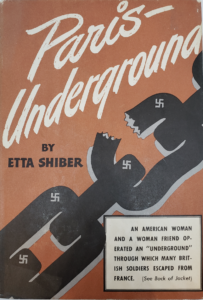 Constance Bennett produced and stars in Paris Underground, which draws on Etta Shiber’s best-selling memoir of the same name (but released in the UK as Madame Pimpernel). Until Shiber and her female confederate were captured and imprisoned by the Nazis, they had helped over 150 English soldiers, left behind in France after its surrender, escape to freedom. At the end of the film, Bennett says that she and her friend (Gracie Fields) rescued “259 British and American airmen.” The book was published in 1943, whereas the film was released after the war in October 1945. This suggests how the final scene was invented, in which Bennett and Fields are shown at an outdoor ceremony in Paris where they are “awarded for exceptional valor and courage” the medal for the Order of Liberation from the French Republic.
Constance Bennett produced and stars in Paris Underground, which draws on Etta Shiber’s best-selling memoir of the same name (but released in the UK as Madame Pimpernel). Until Shiber and her female confederate were captured and imprisoned by the Nazis, they had helped over 150 English soldiers, left behind in France after its surrender, escape to freedom. At the end of the film, Bennett says that she and her friend (Gracie Fields) rescued “259 British and American airmen.” The book was published in 1943, whereas the film was released after the war in October 1945. This suggests how the final scene was invented, in which Bennett and Fields are shown at an outdoor ceremony in Paris where they are “awarded for exceptional valor and courage” the medal for the Order of Liberation from the French Republic.
Spy Noirs Contradict Film Historians’ Conceptions of a Unitary “Asia”
In what follows, I examine discussions by two historians who treat “Asia” in film noir as a single geographical entity and, consequently, as inhabited by people without differences, such as political and military. However, spy noirs (as well as other spy films) contradict this treatment. These historians fail to recognize that during the WWII era Hollywood represented the “East” not as unitary but as binary. That is, there were consistent positive portrayals of China and the Chinese versus extreme negative depictions of Japan and the Japanese.
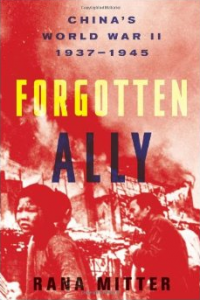 As Rana Mitter explains in Forgotten Ally: China’s World War II, 1937-1945, there has been a loss to the public’s historic memory of China’s war with Japan. “Most Westerners have scarcely heard of the bombing of Chongqing. Even for the Chinese themselves, the events were concealed for decades. Yet they are part of one of the great stories of the Second World War, and perhaps the least known. For decades, our understanding of that global conflict has failed to give a proper account of the role of China. If China was considered at all, it was as a minor player, a bit-part actor in a war where the United States, Soviet Union, and Britain played much more significant roles. Yet China was the first country to face the onslaught of the Axis Powers in 1937, two years before Britain and France, and four years before the United States. And after Pearl Harbor (Dec. 7, 1941), one American goal was to “keep China in the war.” By holding down large numbers of Japanese troops on the mainland, China was an important part of the overall Allied strategy.”24
As Rana Mitter explains in Forgotten Ally: China’s World War II, 1937-1945, there has been a loss to the public’s historic memory of China’s war with Japan. “Most Westerners have scarcely heard of the bombing of Chongqing. Even for the Chinese themselves, the events were concealed for decades. Yet they are part of one of the great stories of the Second World War, and perhaps the least known. For decades, our understanding of that global conflict has failed to give a proper account of the role of China. If China was considered at all, it was as a minor player, a bit-part actor in a war where the United States, Soviet Union, and Britain played much more significant roles. Yet China was the first country to face the onslaught of the Axis Powers in 1937, two years before Britain and France, and four years before the United States. And after Pearl Harbor (Dec. 7, 1941), one American goal was to “keep China in the war.” By holding down large numbers of Japanese troops on the mainland, China was an important part of the overall Allied strategy.”24
Spy noirs about China include all five of the plot types that I describe above. They feature the Japanese armed forces bombing, machine-gunning and raping Chinese civilians. The opening of China Girl says, “The Jap invaders bring the New Order into China – with bullets.” Spy noirs in which the Japanese viciously assault Chinese cities include: Bombs Over Burma (Chongqing), China (Meiki), China Girl (Luichow, Kunming), Destination Unknown (Shanghai), International Settlement (Shanghai), North of Shanghai (Shanghai).
In fact, the second US spy noir, International Settlement was also, according to Daily Variety, “The first feature picture dealing with the bombing and military devastation of Shanghai ready for release…[and]…News clips are effectively inserted with the studio material.”25
Today, Americans are unlikely to know either that Chongqing was China’s wartime capital or the importance (and perils) of supply trucks traveling there. In the WWII era, Hollywood was a source of this information. For example, Burma Convoy opens with a “Foreword” that scrolls on the screen.
“Through the teeming heart of Asia, halfway between Rangoon and Shanghai, twists the hand-hewn Burma Road, lifeline for the embattled Army of China, headquartered at Chungking. Over this seven hundred mile highway roars a stream of trucks – hell-drivers at their wheels – trucks loaded with fuel, munitions, guns – blood and sinew of the defenders of the ancient soil of China.”
It was vital to Japan to close the Burma Road, which it did in April 1942. Besides Burma Convoy, films about the “lifeline” to sustain China’s resistance include: A Yank on the Burma Road, Bombs Over Burma, Half Way to Shanghai, China Girl, Night Plane from Chungking.
For a documentary about the British-Indian army effort to liberate Burma from Japanese control, see Prelude to Victory: Burma, 1942. The description on YouTube is:
“In late 1941 and early 1942 the Imperial Japanese Army swept through the Asia-Pacific region like a wildfire. The Allies appeared powerless to stop them. With the British Army in Asia reeling, and pushed back to the frontier of India, something had to be done to stem the tide. “Prelude to Victory: Burma, 1942” provides context for Field Marshal William J. Slim and the 14th Army’s struggle to retake Burma from the Japanese.”
In most spy noirs about China, Anglo-Americans are the lead characters. Asian Americans, however, aren’t limited to being villains. For example, Anna May Wong, Hollywood’s first Chinese-American film star, is the hero in Bombs Over Burma and Lady from Chungking. Several Asian-American men are frequently cast in roles, varying from film to film, in which they are either good Chinese or bad Japanese. These actors include Korean-American Philip Ahn and Chinese-Americans Richard Loo, Keye Luke and Victor Sen Yung, who are pictured below in sequence.
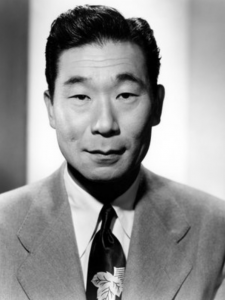
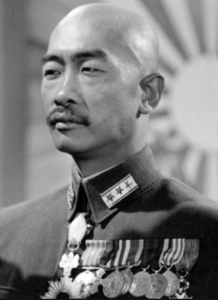
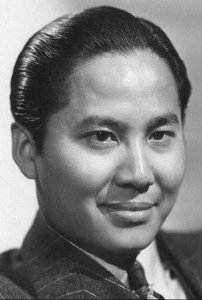
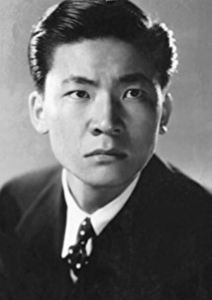
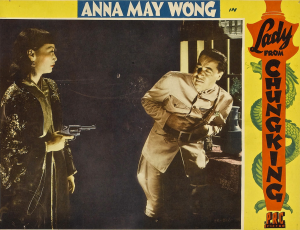 In Lady from Chungking, the leader of local Chinese guerillas, Anna Mae Wong, seduces a Japanese General, Harold Huber, in order to get him to reveal when his soldiers will arrive by train. Her befriending two American pilots leads to the troop train being bombed into oblivion. Wong kills Huber, but before he dies, he has her shot to death. As she is about to be executed, she says:
In Lady from Chungking, the leader of local Chinese guerillas, Anna Mae Wong, seduces a Japanese General, Harold Huber, in order to get him to reveal when his soldiers will arrive by train. Her befriending two American pilots leads to the troop train being bombed into oblivion. Wong kills Huber, but before he dies, he has her shot to death. As she is about to be executed, she says:
“You cannot kill me. You cannot kill China. Not even a million deaths could crush the soul of China. For the soul of China is eternal. When I die, a million will take my place. And nothing can stop them – neither hunger nor torture nor the firing squad. We shall live on until the enemy is driven back over scorched land and hurled into the sea. That time will come soon. The armies of decency and liberty are on the march. For China’s destiny is victory. It will live because human freedom will not perish. Out of the ashes of ruin and old hatreds the course of peace will prevail until the world is again sane and beautiful.”
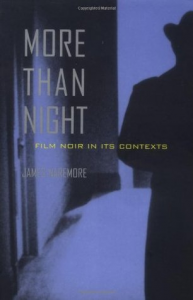 In the sub-chapter, “Asia,” of his book, Nothing More Than Night: Film Noir in Its Contexts, James Naremore inaccurately sees a unitary Asia as represented in film noir. Furthermore, the basis of his error is that he considers film noir as derived from hardboiled fiction. As I explain below, this is a “myth” of the origins of film noir that spy noirs contribute to debunking.
In the sub-chapter, “Asia,” of his book, Nothing More Than Night: Film Noir in Its Contexts, James Naremore inaccurately sees a unitary Asia as represented in film noir. Furthermore, the basis of his error is that he considers film noir as derived from hardboiled fiction. As I explain below, this is a “myth” of the origins of film noir that spy noirs contribute to debunking.
“The Asian theme [in film noir] can in fact be traced back to Dashiell Hammett’s earliest hard-boiled stories for Black Mask, which are saturated with a low brow Orientalism reminiscent of the Yellow Peril years before and after World War I. In ‘The House on Turk Street,’ the Continental Op encounters a gang of killers led by Tai Choon Tau, a wily Chinese man who wears British clothes and speaks with a refined English accent. According to the Op, ‘The Chinese are a thorough people; when one of them carries a gun he usually carries two or three or more,’ and when he shoots, ‘he keeps on until his gun is empty.’
“…[In 1942, John] Houston filmed Across the Pacific, a [Maltese] Falcon spin-off, in which Humphrey Bogart and Mary Astor battle Japanese spies in Panama. This film was, of course, produced during World War II, when images of deceitful and violent Asians from earlier pulp fiction were easily incorporated into anti-Japanese propaganda.”26
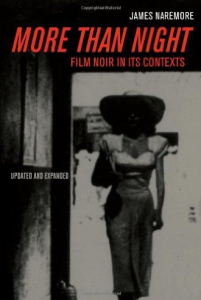 What Naremore sees as consistent, from hardboiled fiction to film noir, is how “Asians” are deceitful and violent – first the Chinese in “earlier pulp fiction,” then the Japanese in WWII film noir. Given that Hollywood politically polarized the bad Japanese against the good Chinese in the WWII era, “Asians” aren’t always deceitful and violent. Naremore’s mistake is inherent in his interpretation of film noir. He posits an “affinity” between film noir and “modernism.” His discussion of the latter focuses on literature. Modernist literature, he says, is “masculine.” Thus, film noir derives from a literary tradition exemplified by hardboiled fiction.27 He ignores Hollywood’s representation of the Chinese in the historical context of World War II. Instead, he takes a literary tradition (“hard-boiled stories”) as the basis of a single theme about Asians – they are deceitful and violent – and because film noir is derived from this literature, Naremore concludes that this “Asian theme” was extended (“easily incorporated”) into film noir.
What Naremore sees as consistent, from hardboiled fiction to film noir, is how “Asians” are deceitful and violent – first the Chinese in “earlier pulp fiction,” then the Japanese in WWII film noir. Given that Hollywood politically polarized the bad Japanese against the good Chinese in the WWII era, “Asians” aren’t always deceitful and violent. Naremore’s mistake is inherent in his interpretation of film noir. He posits an “affinity” between film noir and “modernism.” His discussion of the latter focuses on literature. Modernist literature, he says, is “masculine.” Thus, film noir derives from a literary tradition exemplified by hardboiled fiction.27 He ignores Hollywood’s representation of the Chinese in the historical context of World War II. Instead, he takes a literary tradition (“hard-boiled stories”) as the basis of a single theme about Asians – they are deceitful and violent – and because film noir is derived from this literature, Naremore concludes that this “Asian theme” was extended (“easily incorporated”) into film noir.
A related error in treating “Asian ethnicities” as a single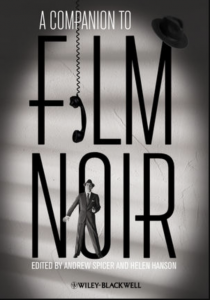 collectivity is committed by Dan Flory in his essay, “Ethnicity and Race in American Film Noir,” in the anthology edited by Andrew Spicer and Helen Hanson, A Companion to Film Noir. Flory’s focus in the essay’s subsection, “Ethnicity in Classic Film Noir,” is about different “ethnicities” and “whiteness.” He says:
collectivity is committed by Dan Flory in his essay, “Ethnicity and Race in American Film Noir,” in the anthology edited by Andrew Spicer and Helen Hanson, A Companion to Film Noir. Flory’s focus in the essay’s subsection, “Ethnicity in Classic Film Noir,” is about different “ethnicities” and “whiteness.” He says:
“Issues of ethnicity are often taken up constructively in works of what might be termed ‘progressive noir’ in the classic period, especially in the years immediately after World War II. In some cases the origins of these films are in literature concerning ethnic prejudice itself. Hierarchies of whiteness that determined disadvantages for ‘borderline whites’ in the United States, such as Italians, Greeks, Poles, and Hispanics, play crucial roles in novels and short stories that serve as the foundation of several noir films….”28
Flory says that some ethnicities (such as Italian Americans and Greek Americans) could have a “positive portrayal” in film noir because “US audiences” (i.e., WASP Americans) “now possessed a less restrictive sense of whiteness in the wake of their wartime experiences.”
“During and after World War II, when millions of US citizens were pulled from their neighborhoods, communities and regions to serve in the armed forces or train far from their places of origin, dedication to a common cause and the mixing of diverse individuals instigated a breakdown of ethnic prejudice and greatly expanded people’s sense of who should be included in the category of whiteness.”29
In short, these “hyphenated Americans” benefitted from an “enlargement of whiteness.”
Flory then considers problematic ethnicities.
“Americans of Hispanic descent and Mexican nationals benefitted as well, but in a noticeably reduced fashion. The former were classified as ‘white’ by the armed forces and unstably joined the dominant racial group. Increasing numbers of both Mexican American and Mexican national characters in film noir reflect this uneasy accommodation….30
“Asian ethnicities present a slightly different constellation of problems. Like the status of Hispanic ethnicity, being Chinese, Japanese or some other Asian group proved more difficult to absorb into whiteness. However, as the noir classic period progressed, some positive characterizations of these groups arose, even if that seemed unlikely at the outset. Early in the noir cycle The Shanghai Gesture (Josef von Sternberg, 1941) conveys a sense of moral panic concerning the ‘yellow peril,’ with the film representing decadence as peculiarly ‘Oriental.’ [Alain] Silver and his fellow authors rightly describe the film as ‘nightmarish,’ but they fail to note that the film roots this quality in racist conceptions of the ‘Orient’ as decadent and something to be feared. What counts as the East here, stretches from Persia to Shanghai and represents exotic, forbidden pleasures and illicit desires….”31
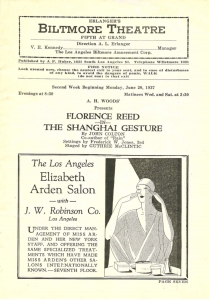
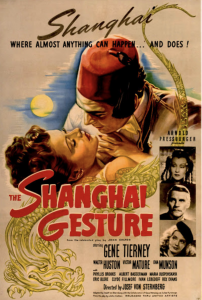
What “Shanghai” is Flory talking about? Flory acknowledges the “racist conceptions” at the “root” of Josef von Sternberg’s film. And, it is worth noting, von Sternberg’s “Shanghai” was a “heavily bowdlerized” version of the original in John Colton’s 1918 play, also called, The Shanghai Gesture. From theater to cinema, “Mother God Damn became Mother Gin Sling. The brothel became a casino. Poppy, instead of being a drug-and-booze-addled nympho, became a compulsive gambler.” The Hollywood version eliminates “a scene of a white girl being auctioned off as a sex slave to lascivious Chinese coolies.” (In the play, the seller is Mother God Damn and the girl is her daughter, who grows up to be Poppy.) No wonder that it was a “controversial play, with protests from the Chinese embassy and accusations of morbid racism.”32
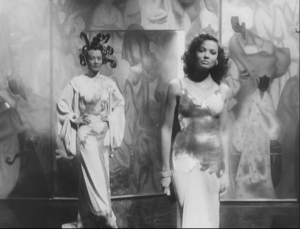 At a dinner party in The Shanghai Gesture, Mother” Gin Sling (Ona Munson) surprises tycoon Walter Huston with his dissolute daughter, Poppy (Gene Tierney), before being shocked to learn that she is the other parent.
At a dinner party in The Shanghai Gesture, Mother” Gin Sling (Ona Munson) surprises tycoon Walter Huston with his dissolute daughter, Poppy (Gene Tierney), before being shocked to learn that she is the other parent.
Flory accepts von Sternberg’s “Shanghai” as representative of the “East,” but only “early in the noir cycle” (during WWII). However, the text at the opening of the film denies that this “Shanghai” can be considered part of the real “Orient” at that time.
“Years ago a speck was torn away from the mystery of China and became Shanghai. A distorted mirror of problems that beset the world today, it grew into a refuge for people who wished to live between the lines of laws and customs – a modern Tower of Babel. Neither Chinese, European, British nor American it maintained itself for years in the ever increasing whirlpool of war. It’s (sic) destiny, at present, is in the lap of the Gods – as is the destiny of all cities. Our story has nothing to do with the present.”
Von Sternberg’s decadent “Shanghai” is imaginary and ahistorical because it has “nothing to do with the present.” In the film an Englishman is taking over large swaths of real estate in the city. In fact, the Japanese had invaded the actual city in 1932, and they didn’t wrest full control from the Chinese until three weeks before the release of the film (December 25, 1941). This Shanghai, the one that was under siege by the Japanese, can be found in film noir – in spy noir. For example, North of Shanghai (released on January 24, 1939), is the first spy noir in which the Japanese are explicitly made the enemy. Here, the things the Chinese do aren’t “illicit”; what they do is heroic.
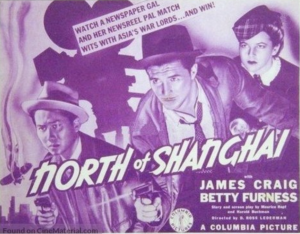
Hollywood’s uplifting depiction of the Chinese didn’t occur because war-time experiences led American WASP audiences to tolerate an “enlargement of whiteness” that extended beyond “hyphenated Americans” of European descent. That is, it didn’t occur because of a racial consideration – the only one that Flory is concerned with. Instead, the positive portrayal of the Chinese (and its opposite, the negative one of the Japanese) was based on political and military considerations: the Chinese were a US ally, whereas the Japanese were an enemy. Spy noirs and other spy films consistently show this dichotomy.
Flory is wrong to allege that “some positive characterizations” of Asians in film noir didn’t occur until the post-war years (“as the classic period progressed”). In the WWII era – in the immediate years before and after the release of The Shanghai Gesture – Hollywood made sure audiences saw the gruesome brutality the Chinese suffered from the Japanese as well as their unbreakable resistance.
In fact, the second US spy noir, International Settlement, was also, according to Daily Variety, “The first feature picture dealing with the bombing and military devastation of Shanghai ready for release…[and]…News clips are effectively inserted with the studio material.”33
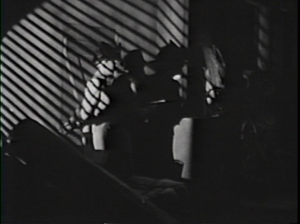 In North of Shanghai, a pistol-toting cameraman (James Craig) and a star reporter (Betty Furness) bust up a pro-Japanese spy ring and avenge the murder of his Chinese friend (Keye Luke), a fellow news photographer.
In North of Shanghai, a pistol-toting cameraman (James Craig) and a star reporter (Betty Furness) bust up a pro-Japanese spy ring and avenge the murder of his Chinese friend (Keye Luke), a fellow news photographer.
Dan Flory and James Naremore share the same two drawbacks in their respective treatments of “Asia” and “Asians.” First, they don’t understand that there is more than crime noir in the noir filmography – there is also spy noir. Second, they don’t recognize the historical context of Asia in World War II, which results in their unitary treatment of Asians.
According to Rana Mitter, the influence of Cold War and post-Cold War politics on American historiography about China explains the ignorance of Americans about the China-US relationship in WWII. Although that argument is beyond the scope of this post, Mitter presents it in the Epilogue of his book. What I want to emphasize is that Hollywood was unwaveringly pro-China during the WWII era in spy noirs (and other spy films).
To see Hollywood’s depiction, at that very time, of America’s “forgotten ally,” as well as to see a different representation of “Asians” in film noir than is given by James Naremore and Dan Flory, I recommend watching the spy noirs that I cite above.
Spy Noirs Refute Claims that Film Noir Is Derived from Hardboiled Crime Fiction
For decades, mass media journalists and academic historians have repeated the same two claims about the origins of film noir. First, its content derives from literature, foremost of which is hardboiled crime fiction. Second, its visual style derives from European émigré film professionals, who drew on their familiarity with expressionism once they were in Hollywood. Spy noirs contribute to exposing both claims as false, that each is only a myth.
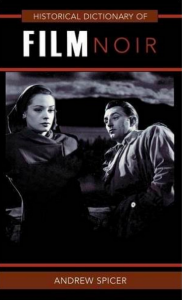 The commentary below, in Andrew Spicer’s Historical Dictionary of Film Noir, under the subsection “THE ORIGINS OF FILM NOIR,” is representative of the first myth.
The commentary below, in Andrew Spicer’s Historical Dictionary of Film Noir, under the subsection “THE ORIGINS OF FILM NOIR,” is representative of the first myth.
“Like any cultural phenomenon, film noir evolved gradually from a variety of different influences. The most obvious and fundamental was indigenous hard-boiled fiction. The works of influential writers such as Dashiell Hammett, Raymond Chandler, James M. Cain, and Cornell Woolrich provided the source for many films noir. Nearly 20 percent of noir crime thrillers produced between 1941 and 1948 were direct adaptations of hard-boiled novels or short stories, and far more were imitations or reworkings….The hard-boiled authors decisively shifted the locale of crime from the country house drawing rooms of the “English school” onto the “mean streets” of the fast growing American city, providing film noir with its characteristic image of the city as a dark, corrupt, threatening, and confusing labyrinth, populated by criminals, tough private eyes, and duplicitous femme fatales.”34
Spicer’s figure of “nearly 20 percent” may be appropriate for his own list of film noirs, yet it cannot be taken as a fact, given that other reference books contain fewer or more titles. Each of the other filmographies would need to be separately assessed. He mentions “far more…imitations and re-workings,” but he doesn’t offer an estimated percentage for these films. In his selected years, by his own calculation, most film noirs aren’t derived from hardboiled fiction. From my analysis of 69 crime noirs, 1940-1944, only 10 (14.5%) come from hardboiled novels (nine) or stories (one).35 Even if my time period is briefer than Spicer’s, were hardboiled fiction, in fact, the “fundamental” influence on film noir, it would have to be demonstrated in the earliest years, which isn’t the case.
What are the sources of other crime noirs? Frequently, it is women’s literature – novels, short stories and plays.36 There are many original screenplays, or screenplays based on unpublished stories, that are unrelated to the hardboiled tradition. The actual number of film noirs featuring private eyes and/or femme fatales suggests that their significance is overrated or, at least, that other characters, like the hunted man and the woman in distress, should get equal billing. In Spicer’s selected years, there are indisputably more crime noirs with a woman in distress than a femme fatale.37 Since I find a paltry 20 crime noirs with a private detective during those years, there is ample reason to challenge the validity of the PI as being an “iconic” character.38
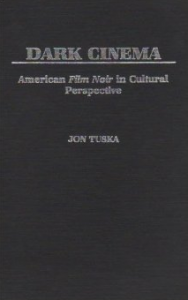 Once we recognize that film noir consists of spy noirs as well as crime noirs, the case grows against hardboiled fiction as “the obvious and fundamental” influence on the origins of film noir. In fact, spy noirs boost the argument against literature as the primary source of film noir. According to my tables, hardly any spy noirs come from “the new school” of espionage literature, personified by Eric Ambler and Graham Greene.39 Yet, in the sole published work I have found that links “spy dramas” with film noir, these films are only derived from spy novels. In Dark Cinema: American Film Noir in Cultural Perspective, Jon Tuska makes a couple of connections between espionage literature and film noir.
Once we recognize that film noir consists of spy noirs as well as crime noirs, the case grows against hardboiled fiction as “the obvious and fundamental” influence on the origins of film noir. In fact, spy noirs boost the argument against literature as the primary source of film noir. According to my tables, hardly any spy noirs come from “the new school” of espionage literature, personified by Eric Ambler and Graham Greene.39 Yet, in the sole published work I have found that links “spy dramas” with film noir, these films are only derived from spy novels. In Dark Cinema: American Film Noir in Cultural Perspective, Jon Tuska makes a couple of connections between espionage literature and film noir.
First, in his chapter on the literary roots of film noir, the section that follows “Hard-Boiled Detective Fiction” is “Other Varieties of Romans Noirs.” Tuska begins with one spy novelist, Eric Ambler, and proceeds to crime writers, chiefly Cornell Woolrich and James M. Cain. He doesn’t mention any other author of espionage fiction.40
Second, in the chapter, “The Film Noir Canon,” Tuska says, “But other genres, or sub-genres, were influenced by the noir visual style and ethos besides Westerns and detective stories. Two primary examples would be ‘fight’ pictures and spy dramas…The noir film style also affected the spy film, particularly those based on the works of Eric Ambler.”41 The only spy noirs Tuska discusses are Journey Into Fear and The Mask of Dimitrios.42
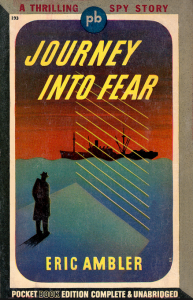
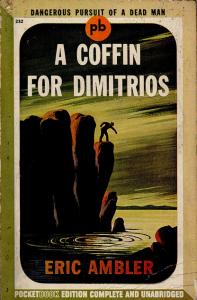
To his credit, Tuska is aware there are spy films that should be included in the filmography of film noir, and his rationale is their visual style. Unfortunately, he restricts his commentary to one factor – the contribution of espionage literature. My research attests that spy noirs arose parallel with this literature. Spy noirs weren’t principally adaptations of spy novels. In fact, there were too few authors in the new school to have written the books for all of the spy noirs released in the WWII era. The writers and the written sources for UK and US spy noirs, which I provide in my tables, are evidence that spy noirs weren’t derivative from spy novels.
Spy Noirs Refute Claims that the Noir Style Is Derived from European Émigrés
Two quotes from Andrew Spicer are representative of the second myth of the origins of film noir.
“There were equally important European influences on film noir, notably expressionism…In Germany, expressionist films…formed part of an international artistic movement that attempted to express the alienation and “irrationality” of modern life through the presentation of protagonists who are tormented or unbalanced. The narratively complex expressionist films created an overall stimmung (mood) and distinct visual style by using high-contrast, chiaroscuro lighting where shafts of intense light contrast starkly with deep, black shadows and where space is fractured into an association of unstable lines and surfaces, often fragmented or twisted into odd angles…[Peter] Lorre was one of many émigrés who fled from Nazi Germany to Hollywood that included [Fritz] Lang and fellow directors Otto Preminger, Robert Siodmak, Edgar G. Ulmer, and Billy Wilder together with cinematographers John Alton, Karl Freund, and Rudolph Maté, and various set designers, scriptwriters, and composers. Carrying with them knowledge and understanding of expressionist cinema, these émigré personnel decisively influenced the development of film noir.43
“Of almost equal importance, though less well-known, was the influence of poetic realism (Réalisme Poétique), cycle of dark films that flourished in France during the 1930s…Poetic realism was indebted to expressionism, but the lighting was less extreme and more atmospheric, its depiction of an urban milieu more realistic and specific…Because poetic realism was not only successful in France but also widely admired internationally, including in America, and because several Austro-German émigrés worked in Paris before going to Hollywood, it acted as a bridge, culturally and historically, between expressionism and film noir.”44
Spicer’s list of émigrés is typical. Logically, to justify the claim that European émigrés “decisively influenced the development of film noir,” their careers in Hollywood had to begin either before or exactly concurrent with the earliest film noirs. If their US careers began later, the claim cannot be valid.
Spicer’s five directors and the three cinematographers are below. Information about their careers and their film noir histories doesn’t support his claim that the American noir style derives from émigrés. For each one, I provide the current name of the country of birth, the date when the career began in the US (or, if the career was entirely in the US, it says, “US career”), and the titles and release dates of the earliest film noirs, including spy noirs and/or crime noirs.
Fritz Lang (Germany; US career: 1934) – Fury (1936), You Only Live Once (1937), Man Hunt (1941)
Otto Preminger (Ukraine; US career: 1936) – Laura (1944), Fallen Angel (1945)
Robert Siodmak (Germany; France, US career: 1933) – Fly-By-Night (1942), Phantom Lady (1944)
Edgar G. Ulmer (Czech Republic; US career) – Prisoner of Japan (1942, uncredited), Bluebeard (1944)
Billy Wilder (Poland, US career: 1934) – Five Graves to Cairo (1943), Double Indemnity (1944)
John Alton (Hungary; US career) – The Devil Pays Off (1941), Storm Over Lisbon (1944)
Karl Freund (Czech Republic; US career: 1929) – The Seventh Cross (1944), Dangerous Partners (1945)
Rudolph Maté (Poland; US career: 1935) – Blockade (1938), Foreign Correspondent (1940), Address Unknown (1944)
The information above highlights two additional problems for historians who claim the American noir style derives from émigrés. Spicer’s filmography has both of them.
First, most historians haven’t acknowledged that US film noir begins before 1940. Thus, the 1930s titles by Lang and Maté don’t appear in their filmographies.
Second, historians haven’t recognized “spy noir” as a category of film noir, despite a few spy films perhaps being included in their filmographies. Thus, the earliest crime noirs for Ulmer, Wilder, Alton, Freund, and Maté are dated after the spy noirs in my tables. For historians like Spicer, the influence of these émigrés on film noir’s development only begins with their crime noirs, yet they were released years after the first spy noirs and also the first crime noirs!
The careers of Ulmer and Alton weren’t formed in Germany but in the US. Without professional experience in Europe, how could they have been, in Spicer’s words, “carrying knowledge and understanding of expressionist cinema” to Hollywood? Besides, neither their spy noirs nor their crime noirs are among the earliest of all film noirs.
There are British spy noirs and crime noirs in the WWII era (see Note 13). What explains the visual style of UK film noirs? Referring to German émigrés, Tony Williams says, “[F]oreign cinematographers certainly influenced their British counterparts….”45 The cinematographers he names are included in my table of UK spy noirs. Compared with the credits of non-German cinematographers, the credits of these émigrés are only a minority, and they mainly come after those of native British cinematographers. Furthermore, on the following page Williams argues that contemporary conditions, not foreigners, led British filmmakers (in this instance, directors) to use a noir style.
“Despite forties journalistic attacks on certain British directors borrowing from ‘morbid’ elements of German expressionism, such appropriations actually resulted from choosing the correct visual style to express particular problems within the British cultural psyche.”46
As my tables indicate, with few exceptions, the directors and cinematographers who were responsible for the development of spy noirs in Britain were born in the UK, and those responsible in America were born in the US. Of nearly all the directors and cinematographers who were born in other countries, their careers were substantially if not entirely in the UK or the US, respectively.
Also, in US crime noirs, 1940-1944, the noir style was principally due to the craft of native-born American directors and cinematographers, not émigrés.47
To claim that film noir (spy noir or crime noir) was developed by European émigrés, from their experience with expressionism and/or poetic realism, is propagating a myth instead of asserting a fact.
What Explains the Noir Style in the Origins of Film Noir?
If the directors and cinematographers who were responsible for the development of film noir weren’t European émigrés well-versed in expressionism, what explains the noir style?
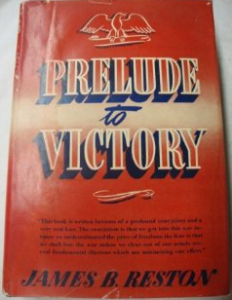 We must consider the timing of the origins of film noir. In the UK and the US, the release of spy noirs began in the mid- to late 1930s and flourished during WWII. And, in both countries, the release of crime noirs started in the mid- to late 1930s, substantially increased throughout the war and flourished in the postwar years. Put simply, the historical context of the WWII era was the primary cause of the noir style. Its anti-classical imagery contrasted with the “classical style” of the pre-WWII era, epitomized by Metro-Goldwyn-Mayer, with its generous lighting, frontal compositions in “natural” perspective, and “invisible” editing.48
We must consider the timing of the origins of film noir. In the UK and the US, the release of spy noirs began in the mid- to late 1930s and flourished during WWII. And, in both countries, the release of crime noirs started in the mid- to late 1930s, substantially increased throughout the war and flourished in the postwar years. Put simply, the historical context of the WWII era was the primary cause of the noir style. Its anti-classical imagery contrasted with the “classical style” of the pre-WWII era, epitomized by Metro-Goldwyn-Mayer, with its generous lighting, frontal compositions in “natural” perspective, and “invisible” editing.48
Valuable evidence of the WWII historical context as the basis for an anti-classical film style was given on the spot by James Reston, a journalist for The New York Times, who specialized in diplomatic and foreign affairs.
His book, Prelude to Victory, was published in the summer of 1942, at the same time the Allies on the battlefields in Asia and Europe, not only North Africa as in Five Graves to Cairo, were reeling from defeats.
“It is necessary now that we admit the facts: many things we have laughed at, or taken for granted, or minimized, or despised in the last few years have risen up to plague us. The little man with the Charlie Chaplin mustache who merely wanted living space for the Germans and could not attack us even if he wanted to is the master of Europe whose submarines are taking pot shots at our East Coast. The little grinning yellow men, the growers of our vegetables, the makers of our cheap toys, the imitators of the West whom we brought into the modern world and could vanquish in three months, are the conquerors of the East. The people we revered, the immortal French, are stricken down and silent; the people we counted out, the plodding English, are still alive; the great mysterious peoples of the East, the Chinese, who were good enough to wash our shirts, and the Russians, who were not, are helping to save our lives. What is this phantasmagoria? How did this come about? What can we do about it? Where do we stand late in the year 1942?49
“…The alternatives before the American people in the closing months of 1942 are both simple and desperate: we must conquer or be conquered; we must learn the lessons of our mistakes or be destroyed by them.”50
In his Preface, Reston says, “We shall lose this war unless we clear out of our minds several fundamental illusions that are minimizing our effort.”51 Each of the book’s eleven chapters is about a different public “illusion” that could prevent an Allied victory. Reston understands that “in the last few years” the world has been turned upside down. The times must have been frightening indeed to warn of the possibility of an Axis conquest of the United States.
Five Graves to Cairo opens in June 1942, the nadir for the Allies in WWII. “By May 1943, after the Germans’ epic defeat at Stalingrad and expulsion from North Africa, there was no doubt among the Allied nations, and little among the Axis peoples, about the outcome of the war.”52 Understandably, as the film was made in the winter of 1943 and released in the late spring, its conclusion is one of confidence that the Allies will be victorious.
Another spy noir, Sherlock Holmes and the Voice of Terror, which was created contemporaneously with Prelude to Victory – in the historical context of American anxiety if not fright – reveals how the world had been turned upside down. (For a fuller analysis of this spy noir, including an explication of the errors committed about the film by Amanda J. Field in her otherwise brilliant England’s Secret Weapon: The Wartime Films of Sherlock Holmes, see the page Sherlock Holmes and the Voice of Terror.)
A man named Gavin is knifed just before he can give vital information to Holmes (Basil Rathbone). As he dies, he gasps one word, “Christopher.” Going back to the late 19th. century, with Holmes’ legacy of solving cases in print, on stage and on screen, one would assume that the great detective himself would conduct the investigation to discover the meaning of that word. After all, he is Sherlock Holmes, and his knowledge of London, and seemingly everything else, is peerless. That assumption, however, fails to take into account the historical context when the screenplay was written and when the film was shot (May 6 – May 23, 1942). As we have seen, it was then an open question whether the Allies could defeat the Axis. Therefore, the timing of the film’s creation explains why this Sherlock Holmes lacks his usual unrivaled intellectual prowess. By himself, he is unable to solve the riddle of “Christopher.”
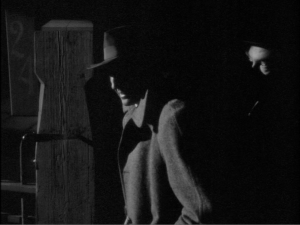 Sherlock Holmes (Basil Rathbone) and Watson (Nigel Bruce) go to an underground beer hall, among the dark and sinister alleys of Limehouse, an East End district in London populated by the working class – and criminals.53 A thrown knife narrowly misses Holmes. Watson is eager to leave Limehouse, but Holmes refuses.
Sherlock Holmes (Basil Rathbone) and Watson (Nigel Bruce) go to an underground beer hall, among the dark and sinister alleys of Limehouse, an East End district in London populated by the working class – and criminals.53 A thrown knife narrowly misses Holmes. Watson is eager to leave Limehouse, but Holmes refuses.
Holmes seeks out Kitty (Evelyn Ankers), the wife of the murdered man. At first Kitty refuses to help Holmes, since it would mean aiding the police, whom she and those of her social class despise. In a remarkable scene, shown below, Holmes pleads with her, arguing that she (not he) has the most intimate knowledge of their city, and only she can mobilize and lead her friends (proletarians) to find out the meaning of “Christopher.” In other words, unwillingness to join the fight against the Nazis must be overcome.
Convinced by Holmes, Kitty walks from one table to another asking what “Christopher” means. No one is willing to help her.
Standing before everyone, she makes a speech, in the scene below. What Kitty wants to do with her suspicious listeners is what James Reston wants to do with his skeptical readers: convince them that their country and, indeed, their freedom are at stake. In fact, the audiences are comparable for Kitty and Reston. In the beer hall it is the working class of the Limehouse; in the American movie theaters it is people of all walks of life. For the British in the film, Kitty’s speech is class-collaborationist and nationalistic propaganda. For the Americans watching the film, it is a post-Pearl Harbor cross-class rallying cry.54
When she finishes so successfully, Holmes says, “Thank you, Kitty,” and Dr. Watson adds, “Well done, my dear.”
Once Kitty reports to Holmes the meaning of “Christopher,” she undertakes a much greater challenge. Risking her life, Kitty agrees to execute an idea by Holmes, which begins when she “accidentally” meets a top Nazi, Meade (Thomas Gomez), as shown below in two parts. To get Meade to reveal the Germans’s plan to invade and conquer Britain, Kitty seduces him and becomes his mistress.
Just before the plot is foiled, thanks to Kitty, Meade shoots and kills her. In his eulogy, Holmes says, “This girl merits our deepest gratitude. Our country is honored in having such loyalty and devotion.”
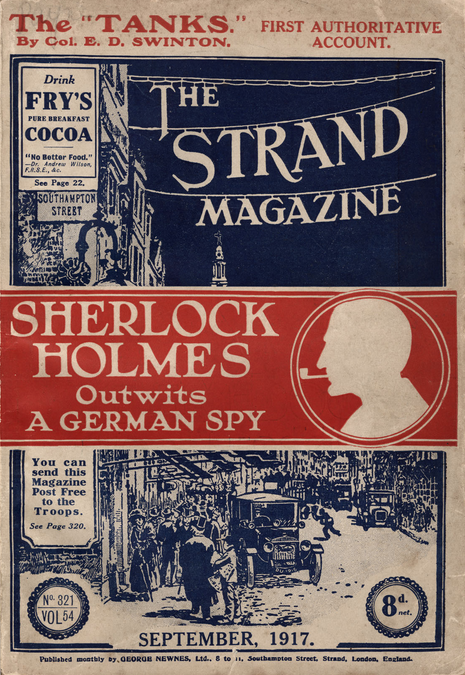 Holmes and Watson step outside the church ruins where the film’s climax takes place, and they look out at the English Channel. Holmes then says, word for word, the East Wind speech from the end of “His Last Bow,” Sir Arthur Conan Doyle’s story on which the film is (mildly) based. It was first published in The Strand Magazine in September 1917, a year after the battle of the Somme and prior to the end of the battle at Passchendaele – another public shocker of ghastly carnage.
Holmes and Watson step outside the church ruins where the film’s climax takes place, and they look out at the English Channel. Holmes then says, word for word, the East Wind speech from the end of “His Last Bow,” Sir Arthur Conan Doyle’s story on which the film is (mildly) based. It was first published in The Strand Magazine in September 1917, a year after the battle of the Somme and prior to the end of the battle at Passchendaele – another public shocker of ghastly carnage.
The context in which Americans heard these words in the film echoes the one a generation earlier when British read them in the story. Holmes’ speech acknowledges and commemorates the sacrifice of lives, like Kitty’s, that has to be endured. For the audience in each World War, the message is the same: as dark as the times are now and may remain in the days ahead, hope and resolve to win the war must not waver.55
In the midst of a worsening nightmare of global scope, the WWII historical context explains why, for an increasing number of British and American spy films and crime films, cinema professionals – whose careers were mainly if not exclusively in the UK and the US – used an anti-classical visual style. (European émigrés weren’t responsible for introducing this imagery. See the page Noir Style by Natives over Émigrés).
Under the dire circumstances of the WWII era, aspects of the classical style were inappropriate for espionage and crime stories. Unlike comedies, musicals and dramas, espionage and crime stories are inextricably involved with some enemy, one that is likely to be evil.56 Within the UK and the US, there were conditions for the psychological escalation of “fear itself,” insofar as war’s savagery and terror, already existing in much of the world, imperiled Britain and threatened America, too. Consequently, for spy films and crime films, it makes perfect sense that the aesthetic response by British and American film craftsmen was to use aspects of anti-classical cinema, the sum of which was the noir style.57
The rise of film noir in the UK overlapped Britain’s war against the Nazis to survive as an independent nation. In the US, film noir emerged at the time of a domestic clash about whether America should or shouldn’t remain a neutral country. And this battle was related to a broader political struggle, triggered by the resurgence of anti-New Deal forces following the “Roosevelt recession.” In other words, the origins of US film noir are to be found in the grim domestic and foreign conditions that heightened insecurities among the American people in the late 1930s.
The Roosevelt Recession and the Return of Economic Fear in America
In 1936, Franklin D. Roosevelt won re-election as president in a historic landslide, losing only Maine and Vermont. Riding on his coattails, huge Democratic victories in both houses of Congress reduced the Republicans to a marginal political party. However, this heyday for American liberalism was to be very brief. By the spring of 1938, FDR had emboldened the GOP opposition following decisive legislative defeats of his proposals to “pack” the Supreme Court and to reorganize the executive branch. Still, what most undermined FDR’s stature – and turned millions of Americans against the Democrats – was the so-called Roosevelt recession. Alan Brinkley reviews this calamity in The End of Reform: New Deal Liberalism in Recession and War.
“The economic crisis of 1937…had ominous similarities to its 1929 counterpart – most visibly in the behavior of the stock market, which collapsed in a great wave of panic selling in mid-October. By the end of 1937, stock prices had fallen by more than a third from their peak in August, by the following spring, the Dow Jones Industrial Average had dropped by 48 percent, achieving in seven months a decline that had taken more than a year in 1929 and 1930…
“But the more disturbing similarity to 1929 was that the collapse of the financial markets in 1937 was only the most dramatic sign of a much broader economic decline…By the end of that winter, industrial production had dropped by more than 40 percent, corporate profits had fallen by 78 percent; four million more workers had swelled the already large unemployment rolls; the national income had slipped by 13 percent from its post-1929 peak of the previous summer. ‘In several particulars,’ Time noted in late November, ‘the Recession is more remarkable than the Depression. It is remarkable because the 35% plummet from last summer’s high is the swiftest decline in the history of U.S. business and finance…’
“And always, behind the strained optimism and the panicky warnings, there was the one great fear: the fear that this crisis, like the 1929 crisis, might move beyond the administration’s control; the fear that the New Deal, so triumphantly vindicated only a year before, might end in failure. The recession was already an economic disaster. It threatened to become a political catastrophe as well.”58
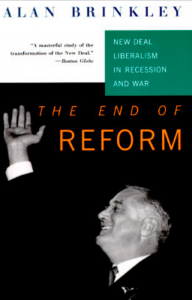 Indeed, the recession did become a political catastrophe – the 1938 mid-term elections “dealt what many considered a death blow to hopes for further New Deal achievements. The Democrats lost eighty seats in the House and eight seats in the Senate. And while the party retained majorities in both chambers, liberals no longer had effective control of Congress.”59 With the second collapse of the US economy within a decade, “fear itself” couldn’t be banished from the public mind. Moreover, as the specter of a second world war within a generation convulsed Asia and Europe, Americans were buffeted by scary circumstances both home and abroad.
Indeed, the recession did become a political catastrophe – the 1938 mid-term elections “dealt what many considered a death blow to hopes for further New Deal achievements. The Democrats lost eighty seats in the House and eight seats in the Senate. And while the party retained majorities in both chambers, liberals no longer had effective control of Congress.”59 With the second collapse of the US economy within a decade, “fear itself” couldn’t be banished from the public mind. Moreover, as the specter of a second world war within a generation convulsed Asia and Europe, Americans were buffeted by scary circumstances both home and abroad.
Gathering strength from the weakening of the New Deal was its antagonist, America’s conservative movement. In addition to combating the expansion of social welfare programs and government “interference” with markets, anti-liberals waged a fight against Hollywood.
Spy Noirs and Interventionists vs. Isolationists
Before Pearl Harbor there was a raging national debate about whether the US should go to war. Pro-interventionists and isolationists accused each other of being fifth columnists.
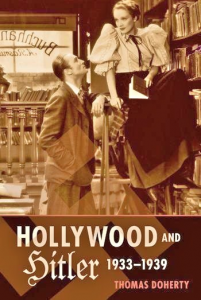 An important angle on this controversy is Thomas Doherty’s Hollywood and Hitler 1933-1939.
An important angle on this controversy is Thomas Doherty’s Hollywood and Hitler 1933-1939.
“As the major studios made tentative incursions into foreign affairs, the actions were cheered or denounced by the interested parties watching from opposite sides in the stands. In a sense, two fifth columns operated behind the scenes in Hollywood—the anti-Nazi activists who sought to inject democratic ideals into Hollywood cinema and the pro-Nazi axis, foreign and domestic, who sought to deflect any criticism, implied or explicit, of Mussolini’s Italy and Hitler’s Germany.”60
Spy films about fifth columnists were understood by Hollywood’s friends and foes alike as warnings that US neutrality enabled Axis supporters, unhindered, to work at weakening the nation’s industrial and military preparedness. Today, like the Chinese-Japanese war, the general public has forgotten the interventionist-isolationist conflict.
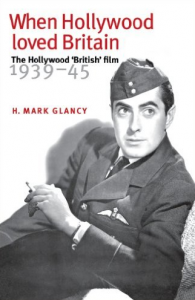 The significance of spy films (including spy noirs) is seen in the attack by isolationists on Hollywood. Their motive is unpacked by H. Mark Glancy in When Hollywood Loved Britain: The Hollywood ‘British’ Film 1939-45.
The significance of spy films (including spy noirs) is seen in the attack by isolationists on Hollywood. Their motive is unpacked by H. Mark Glancy in When Hollywood Loved Britain: The Hollywood ‘British’ Film 1939-45.
“Between the outbreak of war in September 1939 and the attack on Pearl Harbor in December 1941, Hollywood’s war films had progressed steadily and each cautious evasion had been breached. Films that did not mention Germany by name, films that avoided any mention of German Jews, and films that made their statements against dictators in historical costume were followed by increasingly direct portrayals of the need to fight Germany and to support Britain…The box-office success of these films indicates that the American public was ready for them. However, there was still a very vocal isolationist movement in the United States, and organizations such as ‘America First’ – which was reported to have 50,000 members in 1941 – found their last rallying cry in attacking Hollywood.61
“…The isolationists had a list of seventeen films to prove their assertion that Hollywood was undeniably on the side of intervention.”62
In August 1941, largely drafted by America First, a resolution was introduced in the US Senate to investigate Hollywood’s alleged warmongering. In a national radio broadcast, with anti-Semitic innuendos against the Jewish studio moguls, one of the resolution’s sponsors, Senator Gerald P. Nye (Republican, North Dakota), said, “Go to Hollywood. It is a raging volcano of war fever…[It is] the most potent and dangerous Fifth Column in our country.”63
The Congressional hearings took place during September 1941. “To back claims that the industry had purposefully set out to ‘incite the American people to war,’ the list of seventeen films was produced.”64
The list below of the 17 films has the following information: film title, studio, year of release. Eight are spy noirs; three are spy films that lack the noir style; two others are about Nazis and Jews. (They are presented in order of their release.)
Four Sons (Twentieth Century Fox, 1940) – spy noir
The Mortal Storm (Metro-Goldwyn-Mayer, 1940) – rise of Nazi violence against Jews
The Man I Married (Twentieth Century Fox, 1940) – Nazi party member revealed to be Jewish
Mystery Sea Raider (Paramount, 1941) – spy film (Nazi naval saboteur)
Foreign Correspondent (United Artists, 1940) – spy noir
Pastor Hall (United Artists, 1940) – spy noir
Escape (Metro-Goldwyn-Mayer, 1940) – spy noir
Contraband (United Artists, 1940) – spy noir
Night Train to Munich (Twentieth Century Fox, 1940) – spy film (British double agent)
The Devil Commands (Columbia, 1941)
Freedom Radio (Columbia, 1941) – spy noir
So Ends Our Night (United Artists, 1941) – spy noir
The Great Dictator (United Artists, 1941)
That Hamilton Woman (United Artists, 1941)
They Dare Not Love (Columbia, 1941)
One Night in Lisbon (Paramount, 1941) – spy film (Nazi spy ring)
Man Hunt (Twentieth Century Fox, 1941) – spy noir
No film released before Pearl Harbor better stressed the mortal danger the Third Reich posed to the US than Confessions of a Nazi Spy.65 Yet, the film ended with confidence that Americans could take care of themselves and what had happened in Europe wouldn’t repeat here. In the final scene, shown below, an FBI investigator, Edward Renard (Edgar G. Robinson) is at a diner with district attorney Kellogg (Henry O’Neill), who has just successfully prosecuted four fifth columnists. Their conversation has three significant aspects: the noir-like world they were living in, the “terrifying” menace facing the US, and their confidence that America would be spared the fate of countries already invaded by the Wehrmacht.
The film was shot between February – March 1939. The impact of events in the next three years, as presented in James Reston’s Prelude to Victory, led to the loss of that confidence.66
Despite their different initial military and political experiences, Britain and America shared a response in their filmmaking to the rise of fascism. In both countries, dread of Germany and Japan ran parallel to an increasing number of spy films and crime films with an anti-classical imagery. Most of the spy films the isolationists targeted, plus many other spy films released before and afterwards, have an equivalent mise-en-scène with crime films that are considered film noir. Originating in the historical context of the WWII era, the spy films with the noir style are the UK and the US spy noirs in my tables.
Conclusion
A month after the US dropped atomic bombs on Hiroshima and Nagasaki, The House on 92nd Street was released. Referring to an early scene in the film, in his otherwise perceptive commentary for the DVD, Eddie Muller, president of the Film Noir Foundation, says:
“Scenes like this one were actually pretty common in British spy novels and movies. Eric Ambler and Graham Greene specialized in all that British intelligence and espionage type of thing, but it really was not that common in America at this point. The development of a spy network and a counter-spy network just was not really common knowledge to the American people. So the kind of stuff you’re seeing in this film…was pretty new to the American public when this film came out.”67
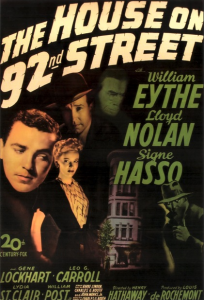
On the contrary, according to my tables, there were far more US than UK spy noirs in the WWII era. From stories by Ambler and Greene, the ratio of American to British spy noirs was 3:1 for each author.
Ambler – US: Journey Into Fear, Background to Danger, The Mask of Dimitrios
Ambler – UK: Hotel Reserve
Greene – US: This Gun for Hire, Ministry of Fear, Confidential Agent
Greene – UK: Went the Day Well?
In The House on 92nd Street, a voice-over says, “The Bureau went to war with Germany long before the hostilities began. No word or picture could then make public the crucial role of the FBI. But now it can be told.”
In fact, by 1945, there had already been many films about good spies from various US government departments, including FBI agents, arresting if not killing fifth columnists and bad spies. Even six year earlier, Confessions of a Nazi Spy had the following similarities with The House on 92nd Street. It drew on real events; it showed FBI methods to break up a spy ring; it used “semi-documentary” techniques; and it had a “Voice of God” narrator.
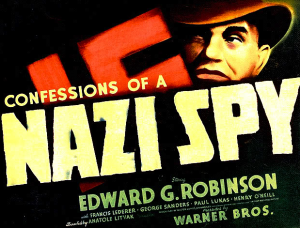
The “development of a spy network and a counter-spy network,” which Muller asserts was “not really common knowledge to the American people” as of 1945, was actually the theme of Espionage Agent, a spy noir released a few months after Confessions of a Nazi Spy.
Two married Americans (Joel McCrea, Brenda Marshall) go to Europe to get proof that there is an organization of enemy agents within the US. Their success results in Congress passing legislation to enable government agencies to engage in counter-espionage. (In the opening of the film we learn there was such a law on the books by the end of WWI, but Congress let it lapse after the Armistice. Twenty years later the US had no legal recourse to defend itself from fifth columnists and foreign spies.)
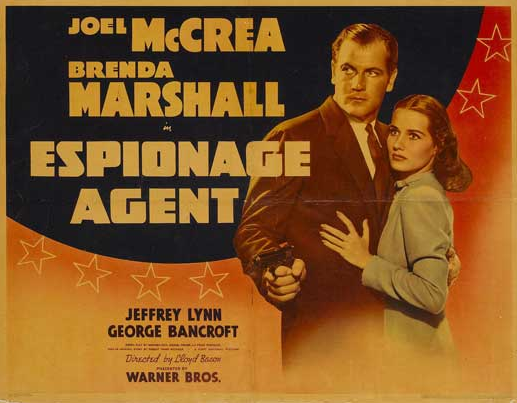
Films like Espionage Agent and Confessions of a Nazi Spy gave audiences insight not only to the threats fifth columnists posed to America before the US entered WWII, but also the counter-espionage actions that federal agencies were taking prior to Pearl Harbor.
Furthermore, well before The House on 92nd Street, that “espionage type of thing” was pervasive on US movie screens: in dramas, comedies, westerns, and whodunits, including films with nearly all of Tinseltown’s serialized private detectives.68 From Poverty Row studios to the majors, the Hollywood dream (nightmare!) factory rolled out spy films almost like armaments plants produced weapons.
With the defeat of the Axis, the historical context was over for the rise and flourishing of the original spy noirs. Consequently, a new theme emerged – the future resurgence of the Nazis (Cornered, Step by Step, Notorious) – which ended in 1948 with two US spy noirs (Berlin Express, Rogues’ Regiment) and two UK spy noirs (Counterblast, Snowbound).
Spy noirs, however, didn’t disappear in the late 1940s. Far fewer in number, they continued to be released in the same years of the classic period of crime noirs. In a changed historical context, there were different threats: the growing Red menace (The Red Menace, I Was a Communist for the FBI, Walk East on Beacon, Pickup on South Street), smuggling illegal immigrants (Illegal Entry, Border Incident, A Lady Without Passport) and stealing secrets for super weapons (The Iron Curtain, Walk a Crooked Mile, 5 Steps to Danger).
Spy noirs are an important cultural record of ways the Second World War was depicted and interpreted through cinema in the UK and the US. In the WWII era, the number of spy noirs released in America and Britain, respectively, was nearly equal to the crime noirs from each country. It is time to improve the accuracy of the history and filmography of film noir by including spy noirs.69
Addendum: Britain’s Two Queens of Spy Films & Spy Noirs
From the early 1930s to the early 1940s, among spy films and spy noirs released in the UK and the US, two women stand out because of the frequency of their appearances. They are the queens; there is no American woman who is comparable. Chronologically, Madeleine Carroll is first, followed by Valerie Hobson.
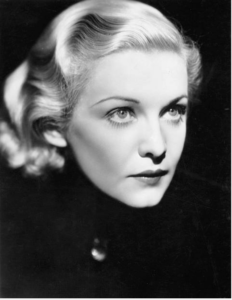
Below is a list of Carroll’s spy films: title, country of release (UK or US), date, director, with male co-star(s). A title that is underlined indicates that it is a spy noir.
I Was a Spy, 1933, UK, Victor Saville, with Herbert Marshall & Conrad Veidt
The 39 Steps, 1935, UK, Alfred Hitchcock, with Robert Donat
The General Died at Dawn, 1936, US, Lewis Milestone, with Gary Cooper
Secret Agent, 1936, UK, Alfred Hitchcock, with John Gielgud & Robert Young
Blockade, 1938, US, William Dieterle, with Henry Fonda
One Night in Lisbon, 1941, US, Edward H. Griffith, with Fred MacMurray
My Favorite Blonde, US, 1942, Sidney Lanfield, with Bob Hope

Below is a list of Hobson’s spy films: title, country of release (UK or US), date, director, with male co-star(s). A title that is underlined indicates that it is a spy noir.
The Great Impersonation, US, 1935, Alan Crosland, with Edmund Lowe
Secret of Stamboul (The Spy in White), UK, 1936, Andrew Marton, with James Mason
Q Planes (Clouds over Europe), UK, 1939, Tim Whelan & Arthur B. Woods, with Laurence Olivier & Ralph Richardson
The Silent Battle (Continental Express), UK, 1939, Herbert Mason, with Rex Harrison
The Spy in Black (U-Boat 29), UK, 1939, Michael Powell, with Conrad Veidt [For a detailed discussion, see the page The Spy in Black.]
Contraband (Blackout), UK, 1940, Michael Powell, with Conrad Veidt
Unpublished Story, UK, 1942, Harold French, with Richard Greene
Adventures of Tartu (Sabotage Agent), US, 1943, Harold S. Bucquet, with Robert Donat
Notes
Below, when there is a quotation from a book within a note, the page reference is provided in parentheses following the quote.
1. For a grand-scale history of espionage by the Allies and the Axis, see Max Hastings, The Secret War: Spies, Ciphers, and Guerrillas, 1939-1945 (Harper, 2016). There is also an audiobook of The Secret War.
Below is a quote from the book, which aptly expresses the sense of the ending of Five Graves to Cairo, as well as many other UK and US spy films. In the film, Mouche, the hotel maid (Anne Baxter), takes responsibility for the murder, which Bramble actually committed, of Rommel’s favorite junior officer (Peter van Eyck). Her confession enables Bramble to go ahead with a mission for Rommel (Erich von Stroheim) to Cairo. And, as Mouche knows, it means Bramble can deliver to the British army the locations of the underground depots. After the Afrika Korps are defeated, Bramble returns to the hotel. Mouche had longed for a special ivory-handled white parasol, and Bramble has it with him to give her. But, as the hotel manager (Akim Tamiroff) tells him, because she stood up to the Nazis, “They beat her and beat her. Then they let her out. One bullet would have been enough.” In the final scene, Bramble goes to a cemetery, opens the parasol and places it in front of the wooden cross that marks Mouche’s grave. In the last two sentences of his Preface, Max Hastings says:
“Hundreds of thousands of many nationalities risked their lives, and many sacrificed them, often in the loneliness of dawn before a firing squad, to gather intelligence or pursue guerrilla operations. No twenty-first century perspective on the personalities and events, successes and failures of those days should diminish our respect, even reverence for the memory of those who paid the price for waging secret war.” (15)
At the end of Five Graves to Cairo, Britain’s Eighth Army routs Rommel’s Afrika Korps at the battle of El Alamein. The Allied victory eliminated the Axis threat to Egypt, the Suez Canal (the lifeline of the British Empire), the vital oil terminal at Haifa and, more broadly, the Middle Eastern and Persian oil fields (the major source of Allied fuel). Winston Churchill said, “Before Alamein we never had a victory. After Alamein we never had a defeat.” The documentary, El Alamein: Erwin Rommel’s Catastrophic Defeat, provides the historical context and the events of the battle, and so, too, the context of Five Graves to Cairo.
2. James Naremore, Nothing More Than Night: Film Noir in Its Contexts (University of California Press, 1998), 15-16.
3. The most notable current film noir reference books that cite French film noirs from the 1930s are as follows: Ginette Vincendeau, “French Film Noir,” in editor Andrew Spicer, European Film Noir (Manchester University Press, 2007), 49-50; Andrew Spicer, Historical Dictionary of Film Noir (Scarecrow Press, Inc., 2010), 97-98, 452-456; John Grant, A Comprehensive Encyclopedia of Film Noir: The Essential Reference Guide (Limelight Editions, 2013); Deborah Walker-Morrison, Classic French Noir: Gender and the Cinema of Fatal Desire (Bloomsbury Academic, 2019), 217-218.
The forthcoming book by Don Malcolm will be the first thorough study in English of French film noir. His chronology, from 1931 – 1966, will include over 400 films. For a sampling, see some of the films Malcolm has presented in programs at the Roxie Theater in San Francisco.
2014: The French Had a Name for It 1: French Film Noir 1946 – 64
2015: The French Had a Name for It 2 – Lovers and Other Strangers
2016: The French Had a Name for It 3 – Further Exploartions in Classic French Film Noir, 1939 – 1965
2017: The French Had a Name for It 4: Despair • Delirium • Destiny — French Film Noir 1935-1966
2018: The French Had a Name for It 5: French Film Noir – The Frenetic Fifties
2019: The French Had a Name for It 5 1/2: Four Decades of French Film Noir
2019: The French Had a Name for It 6: Darkness in the Sixties
2021: The French Had a Name for It ’21: Return of the Suppressed – “Great Films, Less Filling”
2023: The French Had a Name for It ’23
2024: The French Had a Name for It ’24 – Part One
2024: The French Had a Name for It ’24 – Part Two
4. For an overview of Hollywood’s spy films in the WWII era, see “Hollywood Spy Films, 1937-1941” and “Loose Lips Sink Ships: Spies, Saboteurs and Traitors,” in Michael S. Shull and David Edward Wilt, Hollywood War Films, 1937-1945: An Exhaustive Filmography of American Feature-Length Motion Pictures Relating to World War II (McFarland & Company, Inc., 1996), 42-46 and 246-254, respectively.
My definition of spy films is consistent with Alan Furst’s assessment of spy novels in his introduction to The Book of Spies: An Anthology of Literary Espionage (Modern Library, 2003).
“For a collective description of the selections in The Book of Spies, the best phrase I could wrestle out of the language was the literature of clandestine political conflict [italics in the original].” (viii)
5. On the “noir visual style,” see Janey Place and Lowell Paterson, “Some Visual Motifs of Film Noir,” in editors Alain Silver and James Ursini, Film Noir Reader (Limelight Editions, 1996), 64-75; Alain Silver and James Ursini, The Noir Style (The Overlook Press, Peter Mayer Publishers, Inc., 1999); Andrew Spicer, Film Noir (Pearson Education Limited, 2002), 46-47.
6. The most notable current film noir reference books that cite spy films are as follows. Michael F. Keaney, Film Noir Guide: 745 Films of the Classic Era, 1940-1959 (McFarland & Company, Inc., 2003); Michael F. Keaney, British Film Noir Guide (McFarland & Company, Inc., 2008); Robert Murphy, “British Film Noir,” in Andrew Spicer, European Film Noir; Spencer Selby, The Worldwide Film Noir Tradition (Sink Press, 2013); Grant, A Comprehensive Encyclopedia of Film Noir.
Spicer is a good example of the failure of authors of reference books to recognize spy noirs as a category of film noir. In his Historical Dictionary of Film Noir, Spicer has entries for the following types of film noir: boxing, caper/heist, country, gangster, gothic, troubled veteran. He doesn’t mention either Germany or Japan in terms of World War II, nor does he associate film noir with espionage, spies or fifth columnists.
7. Amanda J. Field, England’s Secret Weapon: The Wartime Films of Sherlock Holmes (Middlesex University Press, 2009), 118-119.
8. Sheri Chinen Biesen, Blackout: World War II and the Origins of Film Noir (The Johns Hopkins University Press, 2005).
The greater violence and bloodiness in spy noirs, compared with crime noirs in the WWII era, contributes to the refutation of an alternative interpretation of the origins of film noir. Sheri Chinen Biesen devotes a richly argued book to explaining the emergence of a new kind of crime film cycle toward the end of the Second World War. Although she raises many other issues deserving of rejoinders, in keeping with the key themes of this essay, I will address the following four, one at a time.
I. “[T]he proliferation of the noir series began during – and in many ways, because of – World War II, as a trend spurred by Double Indemnity and enabled by the distinctive wartime factors that created the brooding 1940s period style.” (12)
Biesen considers film noir only in terms of crime films. She ignores spy films and, therefore, spy noirs. Crucially, for her, these crime noirs feature a hardboiled “hero” (e.g., private eye) and a “femme fatale.” Thus, she sees film noir as derivative from hardboiled crime fiction, an error of interpretation that I take up later in my essay.
II. “[F]ully articulated film noir emerged in the United States as an aspect of film production and spectatorship under wartime conditions. Noir evolved as a dark style of ‘realism’ and a wartime Hollywood crime trend described and clearly identified by a term circulated widely, as red meat.” (189)
Biesen dates the beginning of film noir in 1944, with the release of Double Indemnity, which is nearly at the end of WWII. Movies released in prior years, which are considered film noirs by most other historians, she calls “prenoir” or “proto-noir” because they aren’t “red meat.” This term is a synonym for hardboiled, and it pertains to violence, whether it is implicit or explicit in a movie. Biesen associates the origins of film noir only in the American experience. She ignores Britain and France, contrary to most other historians in recent years. She believes WWII, during the early 1940s, was the historical context that led to red meat film noir at the end of the war. She ignores how the historical context both before and after 1939, was the basis for the noir style in spy films, years before 1944.
III. “[R]ed-meat crime men roughed up tough, sexually transgressive women in late wartime and early postwar narratives.” (156)
Biesen ignores the violence in spy noirs, which is considerably greater than Double Indemnity and other crime films she considers film noir in the WWII era. Below in this essay, I discuss physical – including sexual – violence against women in spy noirs, compared to which “roughing up” women in crime noirs utterly pales.
IV. “In the studio system’s shift from wartime to postwar narrative film strategies many companies moved away from portraying simplistic ‘Nazi’ or ‘Jap’ combat enemies to a more complex criminal on-screen.” (190)
Biesen only acknowledges Germans and Japanese as “combat enemies,” which suggests she is restricting portrayals of Axis armed forces to “war movies.” She not only ignores the extreme violence but also the complexity that did get depicted of pro-Axis enemies (spies, fifth columnists) in spy noirs.
For a perspective that is similar to Biesen’s, see Richard Lingeman, The Noir Forties: The American People from Victory to Cold War (Nation Books, 2012), 54-61, 197-200.
9. Captain Hugh Drummond’s bride-to-be, Doris Thompson, is an excellent example of a type of woman analyzed by Christine Grandy in her Heroes and happy endings: Class, gender, and nation in popular film and fiction in interwar Britain (Manchester University Press, 2014) in Chapter 3, “That magic moment: the female love-interest and the villainess.” Thompson conforms to Grandy’s opening sentence of the section of this chapter called, “Working for love, not money:”
“One of the most interesting and common figures in film and fiction popular with British audiences was the working woman who gave up both her independent means of acquiring money and social prestige for love.” (147)
In Bulldog Drummond at Bay there is no mention as to which government “department” Thompson works for nor what her rank as an “officer” is. Still, with such a position it is evident that she is financially independent and has high professional social status. (Furthermore, she isn’t outmatched by Drummond in bringing down the spy ring. For example, although at the climax of the film Drummond saves her from being burned to death, previously Thompson cleverly prevents him from being shot to death.) But, just as Grandy contends, Thompson gives up her exciting and rewarding career as an undercover British government agent when she consents to marry Drummond.
10. Thomas Doherty, Hollywood and Hitler, 1933-1939 (Columbia University Press, 2013); Ben Urwand, The Collaboration: Hollywood’s Pact with Hitler (The Belknap Press of the Harvard University Press, 2013).
11. For an overview of Hollywood’s films of resistance fighters, see “Soldiers Without Uniforms: Wartime Resistance Films,” in Shull and Wilt, Hollywood War Films, 235-246.
In The Secret War, in his chapter, “Guerrilla,” Max Hastings indicates the appropriateness of resistance fighters as one of the five plot types in spy noirs.
“[G]uerrilla campaigns became critical elements of the secret war, eventually commanding resources as large as those expended on intelligence-gathering, and often overlapping with it.” (261)
12. The Seventh Cross (Das Siebte Kreuz) was written in Paris in 1939 by Anna Seghers, a German anti-fascist. Her 1932 novel, The Fellows (Die Gefährten), which warned of the dangers of National Socialism, had led to her arrest by the Gestapo. In 1947, The Seventh Cross received the Georg Büchner Prize, one of Germany’s highest literary honors.
“Anna Seghers.” Wikipedia: The Free Encyclopedia. Wikimedia Foundation, Inc. 05 Mar. 2019. Web. 13 Mar. 2019. <https://en.wikipedia.org/wiki/Anna_Seghers>
13. “Reinhard Heydrich.” Wikipedia: The Free Encyclopedia. Wikimedia Foundation, Inc. 25 Sep. 2018. Web. 25 Sep. 2018. <https://en.wikipedia.org/wiki/Reinhard_Heydrich>; “Lidice.” Wikipedia: The Free Encyclopedia. Wikimedia Foundation, Inc. 01 Mar. 2016. Web. 19 Mar. 2016. <https://en.wikipedia.org/wiki/Lidice>; “Marie Supikova, Survivor of Nazi Terror in Czech Village, Dies at 88.” The New York Times. 20 Apr. 2021. <https://www.nytimes.com/2021/04/18/world/europe/marie-supikova-dead.html?searchResultPosition=1>
14. “Lebensborn.” Wikipedia: The Free Encyclopedia. Wikimedia Foundation, Inc. 28 Aug. 2018. Web. 21 Oct. 2018. <https://en.wikipedia.org/wiki/Lebensborn>
New York Times, 21 Oct. 2018, “Norway Apologizes, 70 Years Later, to Women Who Had Relationships with WWII Germans.”
Cradles of Reich, by Jennifer Coburn (Sourcebooks Landmark, 2022), is reviewed on October 11, 2022, by The Washington Post columnist Kathleen Parker: “A new novel tells the story of Nazi birthing farms.” The book’s dust jacket says, “Based on untold historical events, this novel brings us intimately inside the Lebensborn Society maternity homes that actually existed in several countries during World War II, where thousands of ‘racially fit’ babies were bred and taken from their mothers to be raised as part of the new Germany.”
There are several documentaries on YouTube about the Lebensborn program, the best of which is, from 2023, “The Stomach-Churning Events on Nazi Breeding Farms.”
15. Enzo Traverso, Fire and Blood: The European Civil War 1914-1945 (Verso, 2016).
Enzo Traverso explains the origin of the term, fifth columnist.
“The Spanish [Civil War, 1936-1939] gave birth to a new concept that found its way into every day language: the ‘fifth column.’ In November 1936, when Madrid was under siege by the fascist army, the nationalist General Mola was questioned by the press on his military formation, made up of four columns. He replied that his strategy relied above all on a ‘fifth column,’ that of his supporters inside the besieged city. The ‘fifth column’ thus became synonymous with the ‘enemy within.’” (56)
See also “Fifth column.” Wikipedia: The Free Encyclopedia. Wikimedia Foundation, Inc. 09 Mar. 2016. Web. 24 Mar. 2016. <https://en.wikipedia.org/wiki/Fifth_column>
16. Daniel M. Hodges, “The Rise and Fall of the War Noir,” in editors Alain Silver and James Ursini, Film Noir Reader 4: The Crucial Films and Themes (Amadeus Press/Limelight Editions, 2004), 207-225; Daniel Hodges, “Film Noir Plot Elements: WWII vs. Postwar.” The Film Noir File. WordPress. 13 Oct. 2012. Web. 15 Mar. 2016. <http://www.filmnoirfile.com/film-noir-plot-elements-wwii-vs-postwar/>
17. “Internment of Japanese Americans.” Wikipedia: The Free Encyclopedia. Wikimedia Foundation, Inc. 14 Mar. 2016. Web. 23 Mar. 2016. <https://en.wikipedia.org/wiki/Internment_of_Japanese_Americans>
18. Larry May discusses the “conversion narrative” in WWII films and its relationship to postwar US culture and politics, but he doesn’t directly address spy films (although some titles are cited). Larry May, “Making the American Consensus: The Narrative of Conversion and Subversion in World War II Films,” in editors Lewis A. Erenberg and Susan E. Hirsch, The War in American Culture: Society and Consciousness during World War II (The University of Chicago Press, 1996), 71-102.
See also Larry May, The Big Tomorrow: Hollywood and the Politics of the American Way (The University of Chicago Press, 2000), 230, 277-287.
19. Max Hastings, Inferno: The World at War, 1939-1945 (Alfred A. Knopf, 2011), 79; Clive Ponting, 1940: Myth and Reality, The Truth About Britain’s ‘Finest Hour’ (Ivan R. Dee, 1990), 181-183. “Attack on Mers-el-Kébir.” Wikipedia: The Free Encyclopedia. Wikimedia Foundation, Inc. 02 Feb. 2016. Web. 14 Feb. 2016. <https://en.wikipedia.org/wiki/Attack_on_Mers-el-Kébir>
20. Grant, A Comprehensive Encyclopedia of Film Noir; Keaney, British Film Noir Guide, 230. Murphy, “British Film Noir,” 105-106. (The conclusion of the classic period is also being re-evaluated, as an increasing number of historians propose that the longstanding end date of 1959 should be revised to the mid-1960s.)
21. Jon Tuska, Dark Cinema: American Film Noir in Cultural Perspective (Westport: Greenwood Press, 1984), 202, 203.
The dominant female character types named by Tuska are repeated over the following decades. For example, Spicer, Historical Dictionary of Film Noir, under the entry, WOMEN, says:
“The figure of the deadly female – the femme fatale or spider woman – is the most conspicuous representation of femininity in film noir…The antithesis of the femme fatale…is the figure of the innocent, wholesome homebuilder, the wife or sweetheart…Between these two poles is the “good-bad girl” who combines the sexuality of the femme fatale with the fundamental decency of the homebuilder.” (329-330)
Tuska is mistaken about the importance of “loving wives and mothers,” as is Spicer about “innocent, wholesome homebuilder, the wife or sweetheart.” Consider that one early and notable essay is Sylvia Harvey’s “Woman’s Place: The Absent Family of Film Noir” in editor E. Ann Kaplan, Women in Film Noir (British Film Institute, 1978, 1998).
The actual other main female character is the woman in distress. Furthermore, based on appearances in film noir, the femme fatale is the runner-up. For evidence, see the page Woman in Distress vs. Femme Fatale. For an analysis of the woman in distress, including attention paid to Sorry, Wrong Number, see the page Significance of the Woman in Distress.
22. For an astute analysis of the interaction during WWII between female audiences and female screen characters, see Christine Geraghty’s “Disguises and betrayals: negotiating nationality and femininity in three wartime films,” in editors Christine Gledhill and Gillian Swanson, Nationalizing Femininity: Culture, sexuality and British cinema in the Second World War (Manchester University Press, 1996).
Geraghty assesses three British films, and each one is a spy noir: Yellow Canary, Silver Fleet and Went the Day Well?
23. “Ruby Loftus Screwing Screwing a Breech Ring.” Wikipedia: The Free Encyclopedia. Wikimedia Foundation, Inc. 19 Sept. 2018. Web. 18 Oct. 2018. <https://en.wikipedia.org/wiki/Ruby_Loftus_Screwing_a_Breech_Ring>
24. Daily Variety, 20 January 1938, 3. See “Source Citations” in the “History” page for International Settlement, America Film Institute. <https://catalog.afi.com/Catalog/moviedetails/6023>
25. Rana Mitter, Forgotten Ally: China’s World War II, 1937-1945 (Houghton Mifflin Harcourt, 2013), 4-5.
For an analysis of Hollywood’s representation of China and the Chinese during the WWII era, see “The Eagle and the Dragon,” in Shull and Wilt, Hollywood War Films, 209-211.
26. Naremore, Nothing More Than Night, 225.
27. See chapter 2, “Modernism and Blood Melodrama,” in Naremore, Nothing More Than Night, 40-95.
Because Naremore associates film noir with modernism, especially literature, which is masculine, he ignores sources outside the hardboiled tradition, such as women’s literature (stories, plays, novels) – see Note 21 – as well as original screenplays that aren’t, in Spicer’s terms, hardboiled “imitations or reworkings.”
Futhermore, Naremore’s conception of hardboiled fiction as an expression of masculine, modernist literature is contradicted by Leonard Casssuto.
Leonard Cassuto, Hardboiled Sentimentality: The Secret History of American Crime Stories (Columbia University Press, 2009).
Cassuto says:
“Sentimentalism is stereotypically female in the United States, with the majority of sentimental novels written by women…The heyday of sentimental fiction lasted from the 1820s until the 1880s or so, but the sentimental outlook ranged widely before and since then, and has dispersed throughout the culture. One of the places that sentimentalism dispersed to is hard-boiled storytelling, and there it has made a decisive and long-lasting impact. Hard-Boiled Sentimentality locates the sentimental in the hard-boiled, and ties the persistent place of the sentimental to the development of twentieth century American crime fiction.” (41)
For more on this by Cassuto, see 25-91.
28. “Ethnicity and Race in American Film Noir,” in the anthology edited by Andrew Spicer and Helen Hanson, A Companion to Film Noir (Wiley Blackwell, 2013, 391).
29. Florey,“Ethnicity and Race in American Film Noir,” 392.
30. Florey,“Ethnicity and Race in American Film Noir,” 392.
31. Florey,“Ethnicity and Race in American Film Noir,” 395-396.
32. Vagarian, “THE SHANGHAI GESTURE and John Colton.” Dust and Corruption. 27 Jan. 2012. Web. 04 Dec. 2017. <http://dustandcorruption.blogspot.com/2012/01/shanghai-gesture-by-john-colton.html>
33. American Film Institute, International Settlement, History. <https://catalog.afi.com/Film/6023-INTERNATIONAL-SETTLEMENT?sid=f85df991-297c-4dc2-84cc-2ad6988deec5&sr=15.110654&cp=1&pos=0>
34. Spicer, Historical Dictionary of Film Noir, xl–xli.
35. Daniel Hodges, “Noir Style: Natives – Not Émigrés.” The Film Noir File. WordPress. 18 Oct. 2012. Web. 14 Feb. 2016. <http://www.filmnoirfile.com/noir-style-natives-not-emigres/>
36. Daniel Hodges, “Published Sources: Women’s Noirs.” The Film Noir File. WordPress. 18 Oct. 2012. Web. 14 Feb. 2016. <http://www.filmnoirfile.com/published-sources-womens-noirs/>
37. Daniel Hodges, “Woman in Distress vs. Femme Fatale.” The Film Noir File. WordPress. 19 Oct. 2012. Web. 14 Feb. 2016. <http://www.filmnoirfile.com/woman-in-distress-vs-femme-fatale/>
For an impressive revisionist assessment of the femme fatale, see Julie Grossman, Rethinking the Femme Fatale in Film Noir: Ready for Her Close-Up (Palgrave Macmillan, 2009).
38. Daniel Hodges, “The Missing PI in Film Noir.” The Film Noir File. WordPress. 22 Sep. 2013. Web. 14 Feb. 2016. <http://www.filmnoirfile.com/the-missing-pi-in-film-noir/>.
For a historical critique of the private eye as iconic, see Daniel Hodges, “The Film Noir PI: Made in the ‘70s.” The Film Noir File. WordPress. 22 Sep. 2013. Web. 14 Feb. 2016. <http://www.filmnoirfile.com/the-film-noir-pi-made-in-the-70s/>
39. Brett F.Woods, Neutral Ground: A Political History of Espionage Fiction (Algora Publishing, 2008), 53.
40. Jon Tuska, Dark Cinema, 73-80.
In his chapter, “Modernism and Bloody Melodrama,” James Naremore discusses at length Graham Greene. However, in his analyses of film noirs based on Greene’s novels, he makes no connection between film noir and espionage literature. Naremore, Nothing More than Night, 63-81.
41. Tuska, Dark Cinema, 183.
42. Tuska, Dark Cinema, 187.
43. Spicer, Historical Dictionary of Film Noir, xli–xlii.
44. Spicer, Historical Dictionary of Film Noir, xlii.
45. Tony Williams, “British Film Noir,” in editors Alain Silver & James Ursini, Film Noir Reader 2 (Limelight Editions, 1999), 244.
46. Williams, “British Film Noir,” 245.
47. Daniel Hodges, “Noir Style: Natives – Not Émigrés.”
48. On the “classical style,” see David Bordwell, David, Janet Staiger and Kristin Thompson, The Classical Hollywood Cinema. Film Style & Mode of Production to 1960 (Columbia University Press, 1985), 1-84;
See also Spicer, Film Noir, 45-46.
49. James Reston, Prelude to Victory (Alfred A. Knopf, 1942), 3.
The Preface is dated May 1, 1942. Reston wrote the book during some of the darkest days in US history. See Note 59.
50. Reston, Prelude to Victory, 54.
51. Reston, Prelude to Victory, ix.
Some of the “illusions” Reston unpacks are: “Freedom Comes Easy,” “You Can Do Nothing About It,” and “Time and Money Will Save Us.” About the third illusion, Reston says, “Time is not on our side.”
52. Hastings, Inferno, 368.
53. A brief description of Limehouse was published in an article in The Guardian, “From Cripplegate to Agar Town: inside London’s vanished neighborhoods” (June 24, 2015).
“The opium dens of Chinatown, in Victorian Limehouse, remain infamous but their location is little known. Street names are all that remain of a place that gripped the western imagination for decades. Chinese sailors first arrived in Britain with the East India Company, and a small community settled near modern Westferry. They brought with them opium, which was legal until 1914 and cheaper than beer – no surprise as it was produced by the British in India and forcibly sold to China. The myth of a foreign, sinister but impossibly fascinating and exotic East End grew from the 1870s, and held sway until the second world war. Pennyfields and Limehouse Causeway inspired writers from Charles Dickens and Oscar Wilde to Thomas Burke and Sax Rohmer. It also drove anti-Chinese sentiment, which peaked around the first world war, with riots in Limehouse and political campaigns against sailors “taking British jobs”. After the Blitz, many Chinese moved to Soho and the streets were redeveloped. Just a few names on the map – Amoy Place, Ming Street, Pekin Street – hint at the fantasies kindled in this place.”
Limehouse was a rookery, which is defined as follows:
A “rookery” is a colloquial English term given in the 18th and 19th centuries to a city slum occupied by poor people and frequently also by criminals and prostitutes. Such areas were overcrowded, with low-quality housing and little or no sanitation. Poorly constructed dwellings, built with multiple storeys and often crammed into any area of open ground, created densely-populated areas of gloomy, narrow streets and alleyways.
In the film, despite some risk that may be involved going there, Holmes visits the East End as if he were familiar with it. But this is not Sir Arthur Conan Doyle’s Sherlock Holmes. According to Stephen Knight, “…’The Man with the Twisted Lip’ is the only case where Holmes and the narrative venture for substantial periods into the East End, that poor and dangerous area of London, well-known as threatening, but rarely mentioned in other stories….” “The Man with the Twisted Lip” features an early scene at an opium den.
Stephen Knight, “Doyle, Holmes and London,” in Janice M. Allan and Christopher Pittard, editors, The Cambridge Companion to Sherlock Holmes (Cambridge University Press, 2019, 49).
54. Sherlock Holmes and the Voice of Terror was released in the US on 18 September 1942. It wasn’t released in the UK until October 1943. For this reason, I have associated the historical context of the film’s production and reception with early to mid-1942 America.
55. Lawrence Sondhaus, World War One: The Global Revolution (Cambridge University Press, 2011).
Lawrence Sondhaus explains the significance the Somme and Passchendale.
“The first day of the battle of the Somme, 1 July 1916, was ‘the bloodiest day in the history of the British Army…[with] a staggering 54,470 casualties including 19,240 men killed, most of them by machine-gun fire…The action at the Somme finally ended on November 18.’” (213-214)
“The battle of Passchendaele (also known as the third battle of Ypres) lasted from 31 July-10 November 1917. Total British and Imperial casualties were 420,000 including 146,000 killed. ‘Other than the Somme, Passchendaele ranked as the British Empire’s costliest battle of the war.’” (257)
56. Richard Lingeman, Don’t You Know There’s a War On? The American Home Front, 1941-1945 (Thunder’s Mouth Press/Nation Books, 2003).
About the US, Richard Lingeman says:
“The first months of the war and the time immediately prior to it, brought a wave of spy pictures…These spy melodramas probably mirrored the general anxiety in the air, for intrigue implies a shadowy world, where identities are not what they seem and the enemy lurks in his secret hideaway doing his damage.” (193-194)
Robert Murphy, “British Film Noir.”
About the UK, Robert Murphy says:
“During the war, the impetus to show ordinary people implicated in murky events shifted from murder mysteries and crime thrillers to films dealing with espionage and resistance.” Calling them “perhaps the darkest examples” of these kinds of films, Murphy then cites nine titles, all of which are spy noirs: Traitor Spy, The Spy in Black, Contraband, Cottage to Let, Uncensored, Tower of Terror, The Next of Kin, Unpublished Story, Yellow Canary.” (89-90)
57. The consequences in various forms of art and literature during the global epoch in which the Great Depression was bookended by World War I and World War II include the anti-classical cinema style in the origins of film noir. Four centuries earlier, the marked economic and social changes in Europe led to another reaction against classical styles in multiple art forms, especially in painting and centered in Italy.
For a magisterial study that shows, however unintentionally, the imagery in these paintings is comparable with the noir style, see Arnold Hauser, Mannerism: The Crisis of the Renaissance and the Origin of Modern Art (The Belknap Press of the Harvard University Press, 1986).
58. Alan Brinkley, The End of Reform: New Deal Liberalism in Recession and War (Alfred A. Knopf, Inc., 1995), 28-30.
For the significance of the two legislative defeats, see Brinkley, The End of Reform, 15-23.
For an interpretation of the rise of the “conservative coalition” of Republicans and southern Democrats, which emphasizes the two factions’ mutual hostility toward the increasingly powerful and militant labor movement, see Tracy Roof, American Labor, Congress and the Welfare State, 1935-2010 (The Johns Hopkins Press, 2011), 21-33.
59. Brinkley, The End of Reform, 103.
60. Doherty, Hollywood and Hitler, 210.
61. H. Mark Glancy, When Hollywood Loved Britain: The Hollywood ‘British’ Film 1939-45 (Manchester University Press, 1999), 61.
62. Glancy, When Hollywood Loved Britain, 62.
63. Michael E. Birdwell, Celluloid Soldiers: Warner Bros.’s Campaign Against Nazism (New York University Press, 1999), 155; Glancy, When Hollywood Loved Britain, 62.
64. Glancy, When Hollywood Loved Britain, 63.
After the Congressional hearings in September 1941, there was a break. They were supposed to resume in January 1942, but, after Pearl Harbor, isolationism was a lost cause.
65. Confessions of Nazi Spy was released on 6 May 1939. It was the first film from a major studio (Warner Bros.) to attack explicitly Adolf Hitler and the Nazis.
For an account of the controversies raised by the production, see Doherty, Hollywood and Hitler, 335-346. Other films, from other studios, continued to be released that didn’t name the Nazis as an enemy of the UK or the US.
66. Geoffrey Perrett, Days of Sadness, Years of Triumph: The American People, 1939-1945 (The University of Wisconsin Press, 1985).
Among the events undermining Americans’ confidence in the years, 1939-1942, was the Nazi conquest of Greece in late May 1941. Geoffrey Perrett says:
“[T]he performance of the British had been pathetic and that of the Germans so undeniably brilliant that people once again talked openly and fearfully of Britain’s imminent conquest…Thus, when Roosevelt addressed the nation on May 27, he addressed a people afraid, unhappy and bewildered….” (79)
James Reston’s Prelude to Victory underscored the same sense of foreboding conveyed by Time magazine after the fall of Singapore in mid-February 1942. As quoted by Parrett, “Time mourned: ‘This was the worst week of the war…It was the worst week of the century…Now, as in 1864, the fate of the nation was in the balance.’” (208)
Another severe cause for national alarm came after the Japanese took over America’s sources of rubber. The following three paragraphs are quoted from Daniel Immerwahr, How to Hide an Empire: A History of the Greater United States (Farrar, Straus and Giroux, 2019, 265-266). Quotations in the text are sourced in the book’s Notes (Interior Secretary Harold L. Ickes’s comment written in July 1942; Report of the Rubber Survey Committee issued in September 1942; and President Roosevelt’s comment made in November 1942).
“On December 7/8, 1941, Japan, worried about its own access to rubber and other critical raw materials, expanded beyond China and moved on to the resource-rich lands of Southeast Asia. Within months, it conquered the European colonies that accounted for 97 percent of the US rubber supply. The United States and its allies were virtually cut off.
“It is hard to convey how dire a threat this was. ‘If a survey were made to determine the most frequently asked question in America today, it would probably turn out to be: ‘When are we going to get rubber – and how much?’’ wrote the secretary of the interior in mid-1942. ‘We must get rubber – lots of it – and get it rather quickly, or our whole manner of living will be sadly awry.’
“A high-profile governmental report found the situation ‘so dangerous that unless corrective measures are taken immediately this country will face both a military and civilian collapse.’ A military and civilian collapse? Franklin Delano Roosevelt agreed, adding that in the short time since the report had been issued, ‘the situation has become more acute.’”
67. The House on 92nd. Street. Dir. Henry Hathaway. Perf. William Eythe, Lloyd Nolan, Signe Hasso, Gene Lockhart, and Leo G. Carroll. 1945. Fox Film Noir, 2005. DVD.
68. The serialized private eyes with at least one spy noir are as follows. (The only important sleuths without a spy noir were both played by William Powell — Nick Charles and Philo Vance.)
private eye: date, title(s), actor portraying the detective, country of release
Sexton Blake: 1945, Meet Sexton Blake, David Farrar, UK
Boston Blackie: 1941, Meet Boston Blackie, Chester Morris, 1941, US
Nick Carter: 1939, Nick Carter, Master Detective; 1940, Sky Murder; Walter Pidgeon, US
Charlie Chan: 1940, Charlie Chan in Panama; 1940, Murder Over New York; 1945, The Shanghai Cobra; Sidney Toler, US
Bulldog Drummond: 1937, Bulldog Drummond at Bay, John Lodge, UK; 1938, Bulldog Drummond in Africa, John Howard, US
The Falcon: 1942, A Date with the Falcon, George Sanders; 1942, The Falcon’s Brother, Tom Conway, US
Sherlock Holmes: 1942, Sherlock Holmes and the Secret Weapon; 1942, Sherlock Holmes and the Voice of Terror; Basil Rathbone, US
Mr. Moto: 1939, Mr. Moto’s Last Warning, Peter Lorre, US
Ellery Queen: 1941, Ellery Queen’s Penthouse Mystery, Ralph Bellamy; 1942, Enemy Agents Meet Ellery Queen, William Gargan, US
The Saint: 1941, The Saint’s Vacation, Hugh Sinclair, UK
Michael Shayne: 1942, Blue, White and Perfect, Lloyd Nolan, US
The Lone Wolf: 1939, The Lone Wolf Spy Hunt; 1941, Secrets of the Lone Wolf; 1942, Counter-Espionage; 1943, Passport to Suez; Warren William, US
Mr. Wong: 1938, Mr. Wong, Detective, Boris Karloff, US
69. As an aid to determining post-1946 spy noirs, UK and US spy films in the reference books below may be matched with espionage film noirs cited in the reference books above in Note 2. However, as with spy noirs, 1935-1946, the film noir reference books cannot be relied on to contain all the actual post-1946 spy noirs. In other words, the spy films themselves should be viewed and evaluated. For extensive filmographies of spy films, see: Alun Evans, Brassey’s Guide to War Films (Brassey’s, 2000); Paul Mavis, The Espionage Filmography: The Studio Years 1898 through 1999 (McFarland & Company, Inc., 2001); James Robert Parish and Michael R. Pitts, The Great Spy Pictures (The Scarecrow Press, Inc., 1974); James Robert Parish and Michael R. Pitts, The Great Spy Pictures II (The Scarecrow Press, Inc., 1986); David Quinlan, British Sound Films: United States Releases, 1928-1959 (Barnes & Noble Books, 1985); Terry Rowan, World War II Goes to the Movies & Television Guide (Lulu.com, 2012).
Bibliographies
UK and US Film Noir
John Grant, A Comprehensive Encyclopedia of Film Noir: The Essential Reference Guide (Limelight Editions, 2013)
Michael F. Keaney, British Film Noir Guide (McFarland & Company, Inc., 2008)
Michael F. Keaney, Film Noir Guide: 745 Films of the Classic Era, 1940-1959 (McFarland & Company, Inc., 2003)
Robert Murphy, “British Film Noir,” in Andrew Spicer, editor, European Film Noir (Manchester University Press, 2007)
James Naremore, Nothing More Than Night: Film Noir in Its Contexts (University of California Press, 1998)
Janey Place and Lowell Paterson, “Some Visual Motifs of Film Noir,” in editors Alain Silver and James Ursini, Film Noir Reader (Limelight Editions, 1996)
Spencer Selby, The Worldwide Film Noir Tradition (Sink Press, 2013)
Alain Silver and James Ursini, The Noir Style (The Overlook Press, Peter Mayer Publishers, Inc., 1999)
Andrew Spicer, Historical Dictionary of Film Noir (Scarecrow Press, Inc., 2010)
Andrew Spicer, Film Noir (Pearson Education Limited, 2002
Jon Tuska, Dark Cinema: American Film Noir in Cultural Perspective (Greenwood Press, 1984)
Tony Williams, “British Film Noir,” in editors Alain Silver & James Ursini, Film Noir Reader 2 (Limelight Editions, 1999)
UK and US Spy Films
Alun Evans, Brassey’s Guide to War Films (Brassey’s, 2000)
Amanda J. Field, England’s Secret Weapon: The Wartime Films of Sherlock Holmes (Middlesex University Press, 2009)
Paul Mavis, The Espionage Filmography: The Studio Years 1898 through 1999 (McFarland & Company, Inc., 2001)
James Robert Parish and Michael R. Pitts, The Great Spy Pictures (The Scarecrow Press, Inc., 1974)
James Robert Parish and Michael R. Pitts, The Great Spy Pictures II (The Scarecrow Press, Inc., 1986)
David Quinlan, British Sound Films: United States Releases, 1928-1959 (Barnes & Noble Books, 1984)
Michael S. Shull and David Edward Wilt, Hollywood War Films, 1937-1945: An Exhaustive Filmography of American Feature-Length Motion Pictures Relating to World War II (McFarland & Company, Inc., 1996)
History and Politics of World War II, Cinema, and Spy Films
Michael E. Birdwell, Celluloid Soldiers: Warner Bros.’s Campaign Against Nazism (New York University Press, 1999)
Alan Brinkley, The End of Reform: New Deal Liberalism in Recession and War (Alfred A. Knopf, Inc., 1995)
Thomas Doherty, Hollywood and Hitler 1933-1939 (Columbia University Press, 2013)
Amanda J. Field, England’s Secret Weapon: The Wartime Films of Sherlock Holmes (Middlesex University Press, 2009)
Christine Geraghty, “Disguises and betrayals: negotiating nationality and femininity in three wartime films,” in Christine Gledhill and Gillian Swanson, Nationalizing Femininity: Culture, sexuality and British cinema in the Second World War (Manchester University Press, 1996)
H. Mark Glancy, When Hollywood Loved Britain: The Hollywood ‘British’ Film 1939-45 (Manchester University Press, 1999)
Max Hastings, The Secret War: Spies, Ciphers, and Guerrillas, 1939-1945 (Harper, 2016)
Larry May, “Making the American Consensus: The Narrative of Conversion and Subversion in World War II Films,” in Lewis A. Erenberg and Susan E. Hirsch, The War in American Culture: Society and Consciousness During World War II (The University of Chicago Press, 1996)
Larry May, The Big Tomorrow: Hollywood and the Politics of the American Way (The University of Chicago Press, 2000)
Rana Mitter, Forgotten Ally: China’s World War II, 1937-1945 (Houghton Mifflin Harcourt, 2013)
James Reston, Prelude to Victory (Alfred A. Knopf, 1942)
Ben Urwand, The Collaboration: Hollywood’s Pact with Hitler (The Belknap Press of the Harvard University Press, 2013)
